
Chapter 13 Monopolistic Competition and Oligopoly Answer Key
Multiple Choice Questions
1.
Monopolistic competition means:
AACSB: Analytic
Accessibility: Keyboard Navigation
Blooms: Remember
Difficulty: 1 Easy
Learning Objective: 13-01 List the characteristics of monopolistic competition.
Topic: Monopolistic competition: characteristics
Topic: Monopolistic competition: definition
2.
Monopolistic competition is characterized by a:
AACSB: Analytic
Accessibility: Keyboard Navigation
Blooms: Remember
Difficulty: 1 Easy
Learning Objective: 13-01 List the characteristics of monopolistic competition.
Topic: Monopolistic competition: characteristics
Topic: Monopolistic competition: definition

3.
Under monopolistic competition, entry to the industry is:
AACSB: Analytic
Accessibility: Keyboard Navigation
Blooms: Remember
Difficulty: 1 Easy
Learning Objective: 13-01 List the characteristics of monopolistic competition.
Topic: Monopolistic competition: characteristics
Topic: Monopolistic competition: definition
4.
Monopolistic competition resembles pure competition because:
AACSB: Reflective Thinking
Accessibility: Keyboard Navigation
Blooms: Understand
Difficulty: 2 Medium
Learning Objective: 13-01 List the characteristics of monopolistic competition.
Topic: Monopolistic competition: characteristics
Topic: Monopolistic competition: definition

5.
Which of the following is
not
a basic characteristic of monopolistic competition?
AACSB: Analytic
Accessibility: Keyboard Navigation
Blooms: Remember
Difficulty: 1 Easy
Learning Objective: 13-01 List the characteristics of monopolistic competition.
Topic: Monopolistic competition: characteristics
Topic: Monopolistic competition: definition
6.
Nonprice competition refers to:
AACSB: Analytic
Accessibility: Keyboard Navigation
Blooms: Remember
Difficulty: 1 Easy
Learning Objective: 13-01 List the characteristics of monopolistic competition.
Topic: Monopolistic competition: characteristics
Topic: Monopolistic competition: definition

7.
The restaurant, legal assistance, and clothing industries are each illustrations of:
AACSB: Reflective Thinking
Accessibility: Keyboard Navigation
Blooms: Apply
Difficulty: 2 Medium
Learning Objective: 13-01 List the characteristics of monopolistic competition.
Topic: Monopolistic competition: characteristics
Topic: Monopolistic competition: definition
8.
If the number of firms in a monopolistically competitive industry increases and the degree
of product differentiation diminishes:
AACSB: Reflective Thinking
Accessibility: Keyboard Navigation
Blooms: Understand
Difficulty: 2 Medium
Learning Objective: 13-01 List the characteristics of monopolistic competition.
Topic: Monopolistic competition: characteristics
Topic: Monopolistic competition: definition

9.
Economic analysis of a monopolistically competitive industry is more complicated than
that of pure competition because:
AACSB: Reflective Thinking
Accessibility: Keyboard Navigation
Blooms: Understand
Difficulty: 2 Medium
Learning Objective: 13-01 List the characteristics of monopolistic competition.
Topic: Monopolistic competition: characteristics
Topic: Monopolistic competition: definition
10.
A monopolistically competitive industry combines elements of both
competition
and
monopoly
. The monopoly element results from:
AACSB: Reflective Thinking
Accessibility: Keyboard Navigation
Blooms: Understand
Difficulty: 2 Medium
Learning Objective: 13-01 List the characteristics of monopolistic competition.
Topic: Monopolistic competition: characteristics
Topic: Monopolistic competition: definition

11.
A significant difference between a monopolistically competitive firm and a purely
competitive firm is that the:
AACSB: Reflective Thinking
Accessibility: Keyboard Navigation
Blooms: Understand
Difficulty: 2 Medium
Learning Objective: 13-01 List the characteristics of monopolistic competition.
Topic: Monopolistic competition: characteristics
Topic: Monopolistic competition: definition
12.
A monopolistically competitive industry combines elements of both
competition
and
monopoly
. It is correct to say that the competitive element results from:
AACSB: Reflective Thinking
Accessibility: Keyboard Navigation
Blooms: Understand
Difficulty: 2 Medium
Learning Objective: 13-01 List the characteristics of monopolistic competition.
Topic: Monopolistic competition: characteristics
Topic: Monopolistic competition: definition

13.
Monopolistically competitive and purely competitive industries are similar in that:
AACSB: Reflective Thinking
Accessibility: Keyboard Navigation
Blooms: Understand
Difficulty: 2 Medium
Learning Objective: 13-01 List the characteristics of monopolistic competition.
Topic: Monopolistic competition: characteristics
Topic: Monopolistic competition: definition
14.
The monopolistic competition model assumes that:
AACSB: Analytic
Accessibility: Keyboard Navigation
Blooms: Remember
Difficulty: 1 Easy
Learning Objective: 13-01 List the characteristics of monopolistic competition.
Topic: Monopolistic competition: characteristics
Topic: Monopolistic competition: definition

15.
Use your basic knowledge and your understanding of market structures to answer this
question. Which of the following companies most closely approximates a monopolistic
competitor?
AACSB: Reflective Thinking
Accessibility: Keyboard Navigation
Blooms: Apply
Difficulty: 2 Medium
Learning Objective: 13-01 List the characteristics of monopolistic competition.
Topic: Monopolistic competition: characteristics
Topic: Monopolistic competition: definition
16.
A monopolistically competitive firm has a:
AACSB: Reflective Thinking
Accessibility: Keyboard Navigation
Blooms: Remember
Difficulty: 1 Easy
Learning Objective: 13-01 List the characteristics of monopolistic competition.
Topic: Monopolistic competition: characteristics
Topic: Monopolistic competition: definition

17.
The monopolistically competitive seller's demand curve will become more elastic the:
AACSB: Reflective Thinking
Accessibility: Keyboard Navigation
Blooms: Understand
Difficulty: 2 Medium
Learning Objective: 13-02 Explain why monopolistic competitors earn only a normal profit in the long run.
Topic: Price and output in monopolistic competition
18.
The larger the number of firms and the smaller the degree of product differentiation the:
AACSB: Reflective Thinking
Accessibility: Keyboard Navigation
Blooms: Understand
Difficulty: 2 Medium
Learning Objective: 13-02 Explain why monopolistic competitors earn only a normal profit in the long run.
Topic: Price and output in monopolistic competition

19.
The demand curve of a monopolistically competitive producer is:
AACSB: Reflective Thinking
Accessibility: Keyboard Navigation
Blooms: Understand
Difficulty: 2 Medium
Learning Objective: 13-02 Explain why monopolistic competitors earn only a normal profit in the long run.
Topic: Price and output in monopolistic competition
20.
A monopolistically competitive firm's marginal revenue curve:
AACSB: Reflective Thinking
Accessibility: Keyboard Navigation
Blooms: Remember
Difficulty: 1 Easy
Learning Objective: 13-02 Explain why monopolistic competitors earn only a normal profit in the long run.
Topic: Price and output in monopolistic competition

21.
The price elasticity of a monopolistically competitive firm's demand curve varies:
AACSB: Reflective Thinking
Accessibility: Keyboard Navigation
Blooms: Understand
Difficulty: 2 Medium
Learning Objective: 13-02 Explain why monopolistic competitors earn only a normal profit in the long run.
Topic: Price and output in monopolistic competition
22.
In the short run, a profit-maximizing monopolistically competitive firm sets it price:
AACSB: Reflective Thinking
Accessibility: Keyboard Navigation
Blooms: Understand
Difficulty: 2 Medium
Learning Objective: 13-02 Explain why monopolistic competitors earn only a normal profit in the long run.
Topic: Price and output in monopolistic competition
23.
In the long run, a profit-maximizing monopolistically competitive firm sets it price:
AACSB: Reflective Thinking

Accessibility: Keyboard Navigation
Blooms: Understand
Difficulty: 2 Medium
Learning Objective: 13-02 Explain why monopolistic competitors earn only a normal profit in the long run.
Topic: Price and output in monopolistic competition
24.
In the short run, the price charged by a monopolistically competitive firm attempting to
maximize profits:
AACSB: Reflective Thinking
Accessibility: Keyboard Navigation
Blooms: Understand
Difficulty: 2 Medium
Learning Objective: 13-02 Explain why monopolistic competitors earn only a normal profit in the long run.
Topic: Price and output in monopolistic competition
25.
In the long run, the price charged by the monopolistically competitive firm attempting to
maximize profits:
AACSB: Reflective Thinking
Accessibility: Keyboard Navigation
Blooms: Understand
Difficulty: 2 Medium
Learning Objective: 13-02 Explain why monopolistic competitors earn only a normal profit in the long run.
Topic: Price and output in monopolistic competition

26.
Monopolistically competitive firms:
AACSB: Reflective Thinking
Accessibility: Keyboard Navigation
Blooms: Understand
Difficulty: 2 Medium
Learning Objective: 13-02 Explain why monopolistic competitors earn only a normal profit in the long run.
Topic: Price and output in monopolistic competition
27.
The monopolistically competitive seller maximizes profit by producing at the point where:
AACSB: Reflective Thinking
Accessibility: Keyboard Navigation
Blooms: Understand
Difficulty: 2 Medium
Learning Objective: 13-02 Explain why monopolistic competitors earn only a normal profit in the long run.
Topic: Price and output in monopolistic competition
28.
In the long run, the price charged by a monopolistically competitive firm seeking to
maximize profit will:
AACSB: Reflective Thinking

Accessibility: Keyboard Navigation
Blooms: Understand
Difficulty: 2 Medium
Learning Objective: 13-02 Explain why monopolistic competitors earn only a normal profit in the long run.
Topic: Price and output in monopolistic competition
29.
Which of the following is
correct
for a monopolistically competitive firm in long-run
equilibrium?
AACSB: Reflective Thinking
Accessibility: Keyboard Navigation
Blooms: Understand
Difficulty: 2 Medium
Learning Objective: 13-02 Explain why monopolistic competitors earn only a normal profit in the long run.
Topic: Price and output in monopolistic competition
30.
In the long run, economic theory predicts that a monopolistically competitive firm will:
AACSB: Reflective Thinking
Accessibility: Keyboard Navigation
Blooms: Understand
Difficulty: 2 Medium
Learning Objective: 13-02 Explain why monopolistic competitors earn only a normal profit in the long run.
Topic: Price and output in monopolistic competition
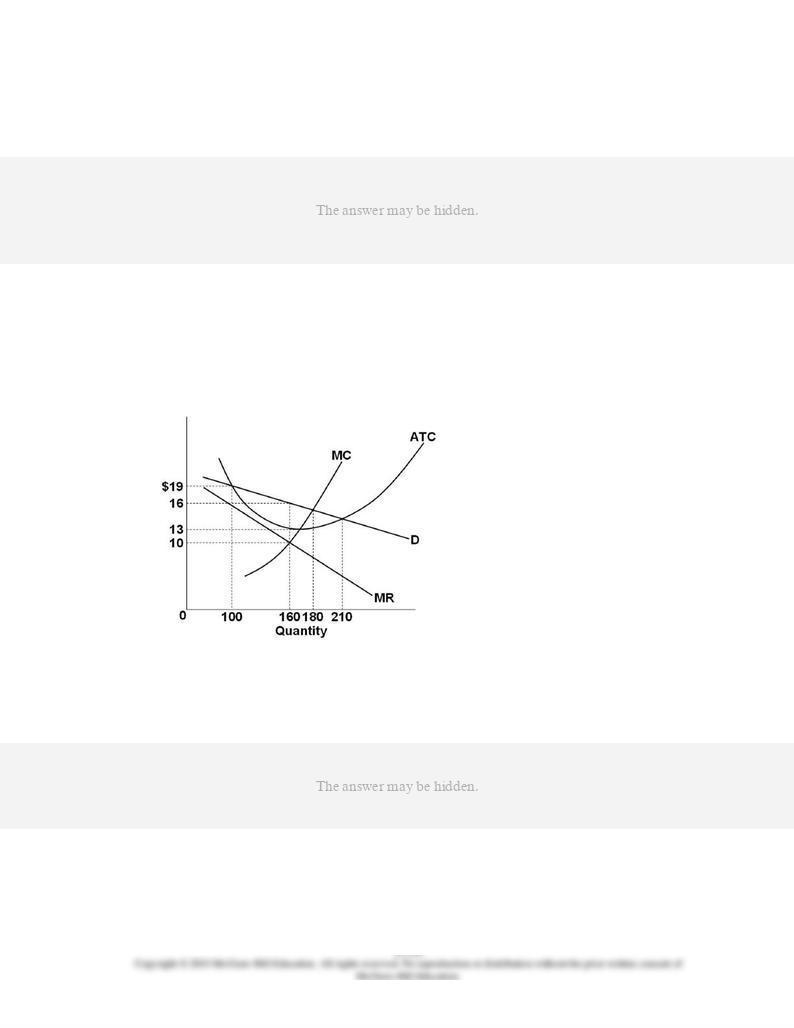
31.
Excess capacity refers to the:
AACSB: Analytic
Accessibility: Keyboard Navigation
Blooms: Remember
Difficulty: 1 Easy
Learning Objective: 13-02 Explain why monopolistic competitors earn only a normal profit in the long run.
Topic: Price and output in monopolistic competition
32.
Refer to the diagram for a monopolistically competitive firm in short-run equilibrium. This
firm's profit-maximizing price will be:
AACSB: Analytic
Blooms: Analyze
Difficulty: 3 Hard
Learning Objective: 13-02 Explain why monopolistic competitors earn only a normal profit in the long run.
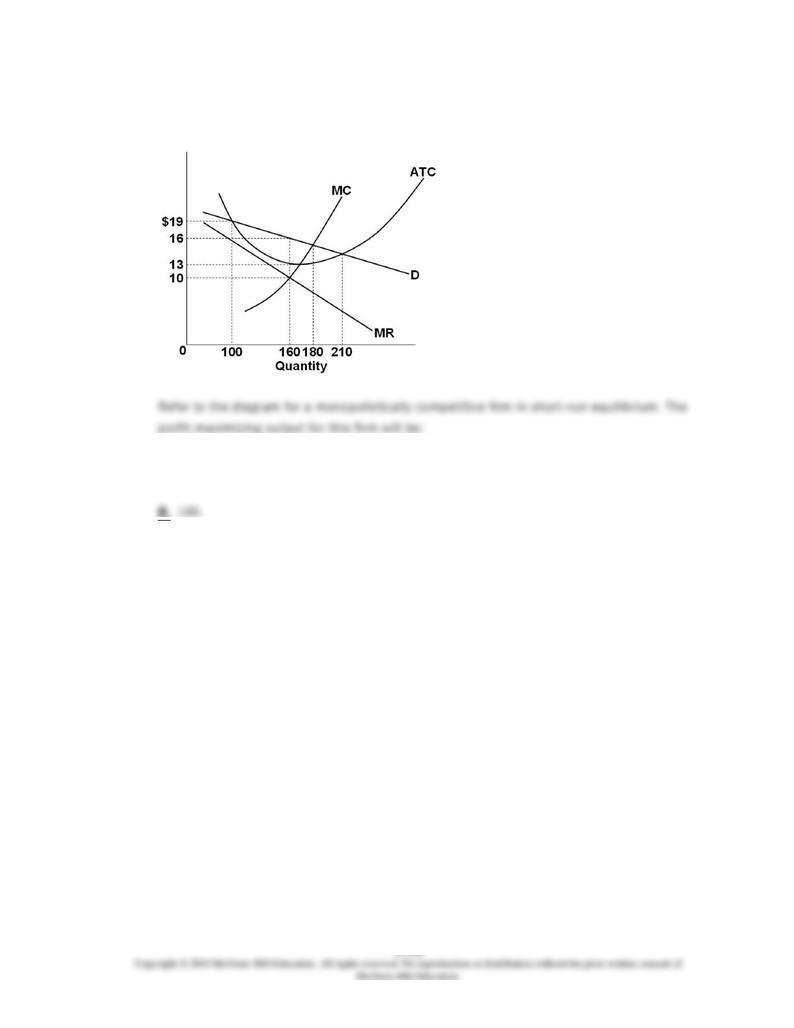
Topic: Price and output in monopolistic competition
Type: Graph
33.
A.
100.
C.
180.
D.
210.
AACSB: Analytic
Blooms: Analyze
Difficulty: 3 Hard
Learning Objective: 13-02 Explain why monopolistic competitors earn only a normal profit in the long run.
Topic: Price and output in monopolistic competition
Type: Graph
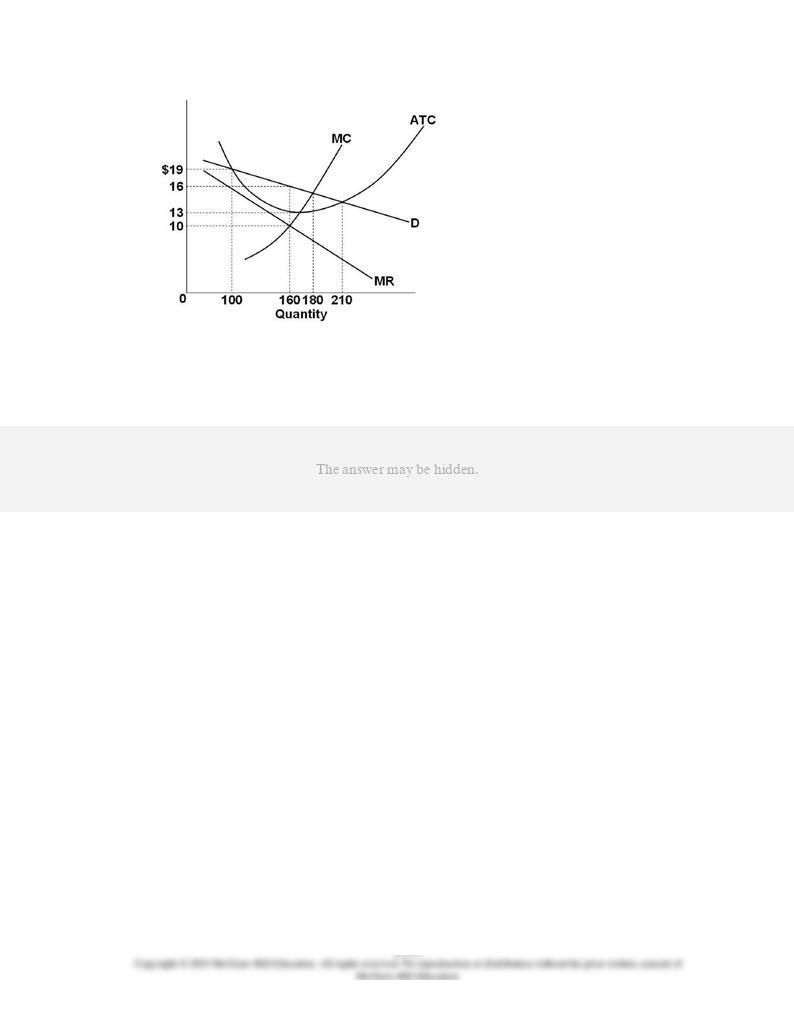
34.
Refer to the diagram for a monopolistically competitive firm in short-run equilibrium. This
firm will realize an economic:
AACSB: Analytic
Blooms: Analyze
Difficulty: 3 Hard
Learning Objective: 13-02 Explain why monopolistic competitors earn only a normal profit in the long run.
Topic: Price and output in monopolistic competition
Type: Graph

35.
In short-run equilibrium, the monopolistically competitive firm shown will set its price:
AACSB: Reflective Thinking
Blooms: Analyze
Difficulty: 3 Hard
Learning Objective: 13-02 Explain why monopolistic competitors earn only a normal profit in the long run.
Topic: Price and output in monopolistic competition
Type: Graph
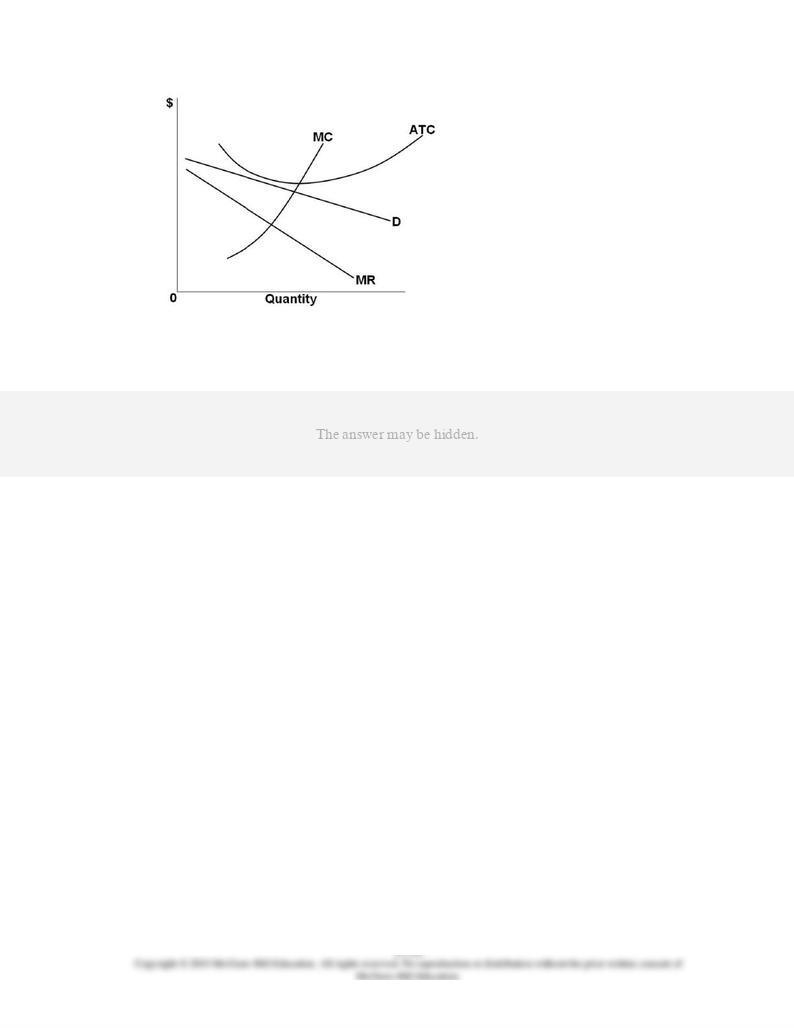
36.
The monopolistically competitive firm shown in the figure:
AACSB: Reflective Thinking
Blooms: Analyze
Difficulty: 3 Hard
Learning Objective: 13-02 Explain why monopolistic competitors earn only a normal profit in the long run.
Topic: Price and output in monopolistic competition
Type: Graph
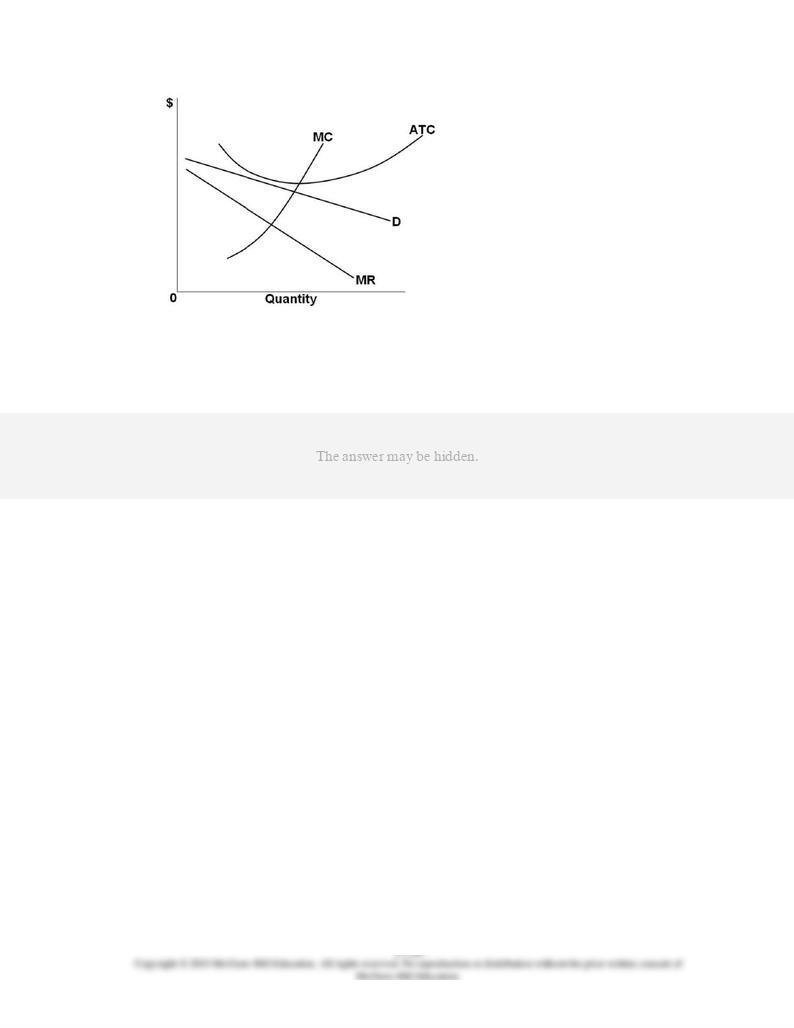
37.
If all monopolistically competitive firms in the industry have profit circumstances similar to
the firm shown:
AACSB: Reflective Thinking
Blooms: Analyze
Difficulty: 3 Hard
Learning Objective: 13-02 Explain why monopolistic competitors earn only a normal profit in the long run.
Topic: Price and output in monopolistic competition
Type: Graph

38.
Refer to the diagram. In short-run equilibrium, the monopolistically competitive firm shown
will set its price:
AACSB: Reflective Thinking
Blooms: Analyze
Difficulty: 3 Hard
Learning Objective: 13-02 Explain why monopolistic competitors earn only a normal profit in the long run.
Topic: Price and output in monopolistic competition
Type: Graph
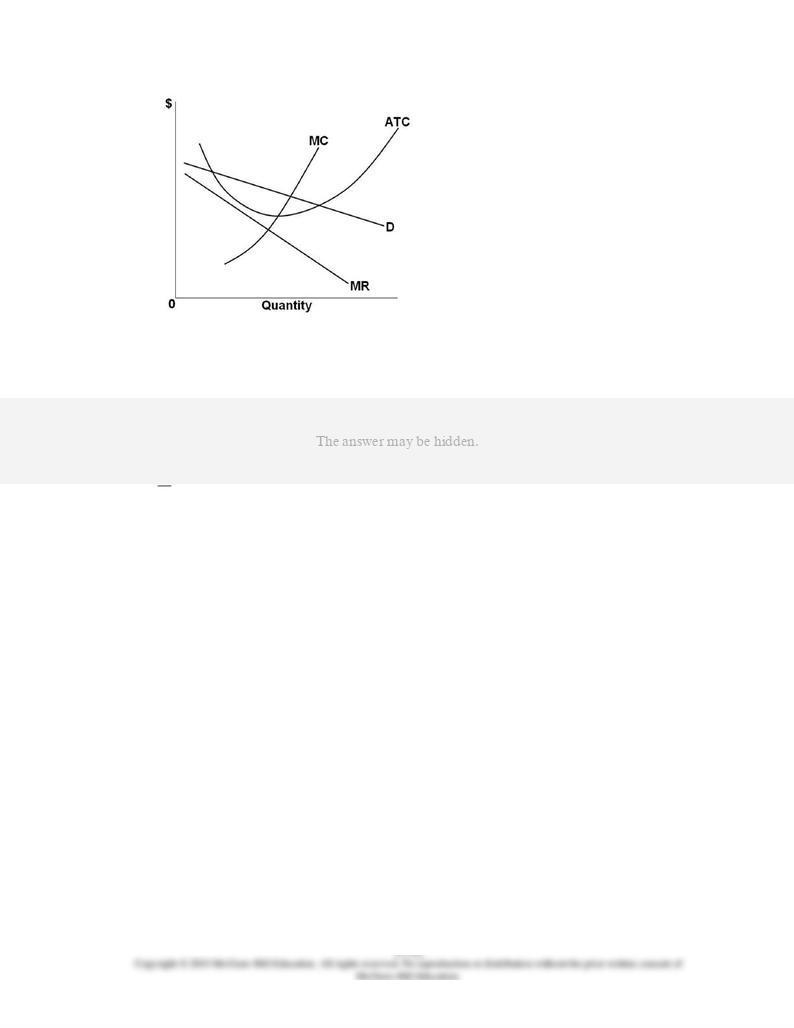
39.
Refer to the diagram. The monopolistically competitive firm shown:
AACSB: Reflective Thinking
Blooms: Analyze
Difficulty: 3 Hard
Learning Objective: 13-02 Explain why monopolistic competitors earn only a normal profit in the long run.
Topic: Price and output in monopolistic competition
Type: Graph
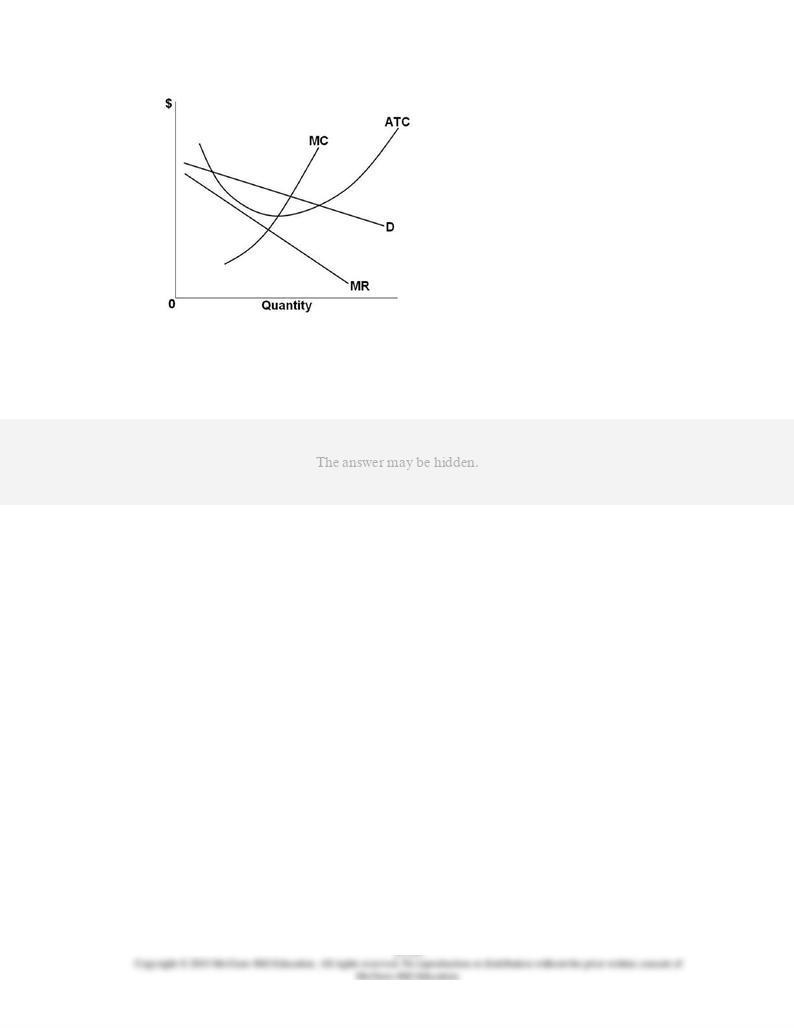
40.
Refer to the diagram. If all monopolistically competitive firms in the industry have profit
circumstances similar to the firm shown above:
AACSB: Reflective Thinking
Blooms: Analyze
Difficulty: 3 Hard
Learning Objective: 13-02 Explain why monopolistic competitors earn only a normal profit in the long run.
Topic: Price and output in monopolistic competition
Type: Graph
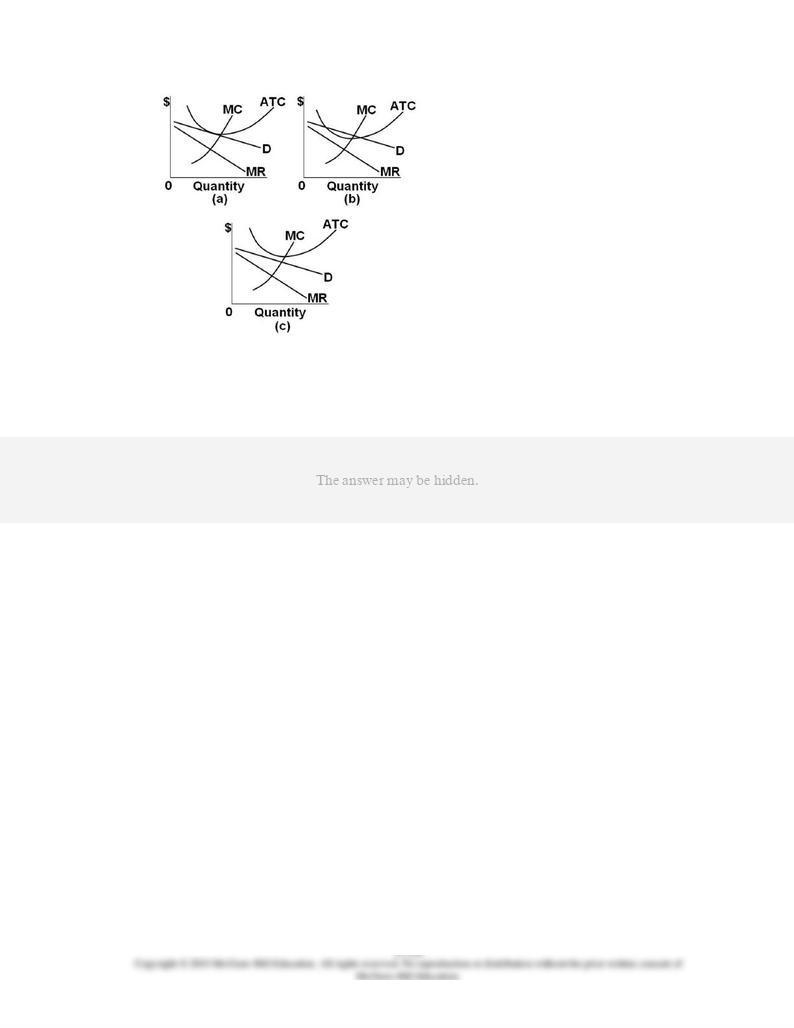
41.
Refer to the diagrams, which pertain to monopolistically competitive firms. Short-run
equilibrium entailing economic loss is shown by:
AACSB: Reflective Thinking
Blooms: Understand
Difficulty: 2 Medium
Learning Objective: 13-02 Explain why monopolistic competitors earn only a normal profit in the long run.
Topic: Price and output in monopolistic competition
Type: Graph

42.
Refer to the diagrams, which pertain to monopolistically competitive firms. A short-run
equilibrium entailing economic profits is shown by:
AACSB: Reflective Thinking
Blooms: Understand
Difficulty: 2 Medium
Learning Objective: 13-02 Explain why monopolistic competitors earn only a normal profit in the long run.
Topic: Price and output in monopolistic competition
Type: Graph
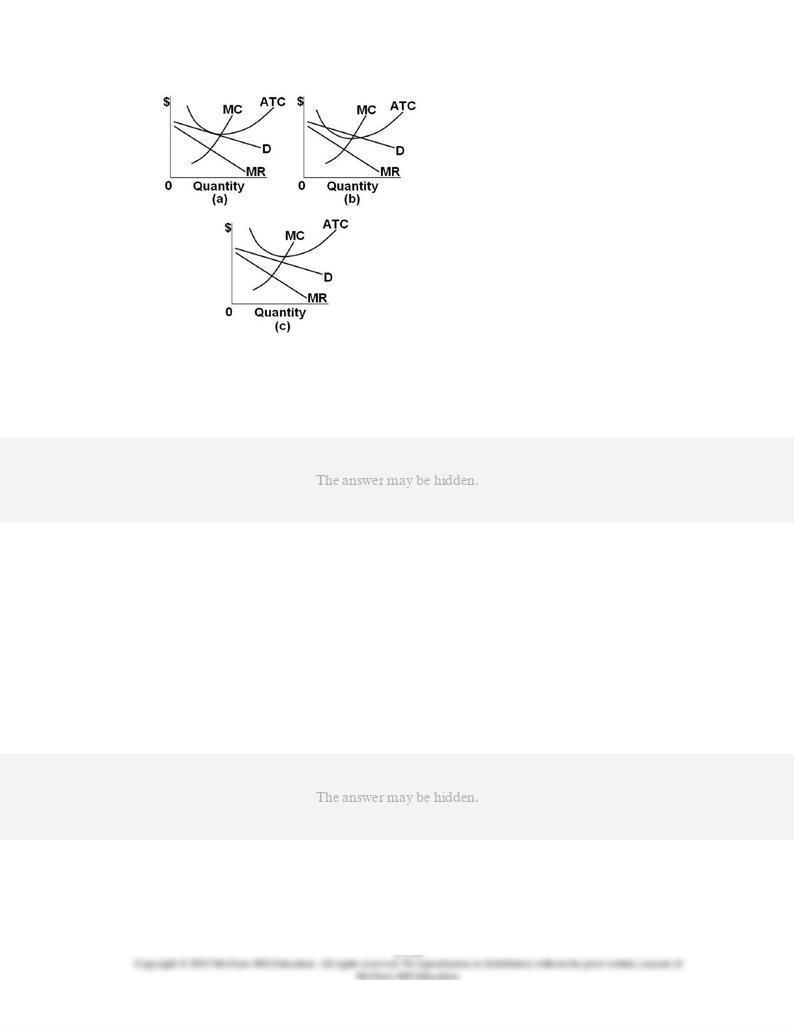
43.
Refer to the diagrams, which pertain to monopolistically competitive firms. Long-run
equilibrium is shown by:
AACSB: Reflective Thinking
Blooms: Understand
Difficulty: 2 Medium
Learning Objective: 13-02 Explain why monopolistic competitors earn only a normal profit in the long run.
Topic: Price and output in monopolistic competition
Type: Graph
44.
Which of the following is
not
characteristic of long-run equilibrium under monopolistic
competition?
AACSB: Reflective Thinking
Accessibility: Keyboard Navigation
Blooms: Understand
Difficulty: 2 Medium

Learning Objective: 13-02 Explain why monopolistic competitors earn only a normal profit in the long run.
Topic: Price and output in monopolistic competition
45.
Refer to the diagram for a monopolistically competitive firm. Long-run equilibrium price
will be:
AACSB: Reflective Thinking
Blooms: Analyze
Difficulty: 3 Hard
Learning Objective: 13-02 Explain why monopolistic competitors earn only a normal profit in the long run.
Topic: Price and output in monopolistic competition
Type: Graph
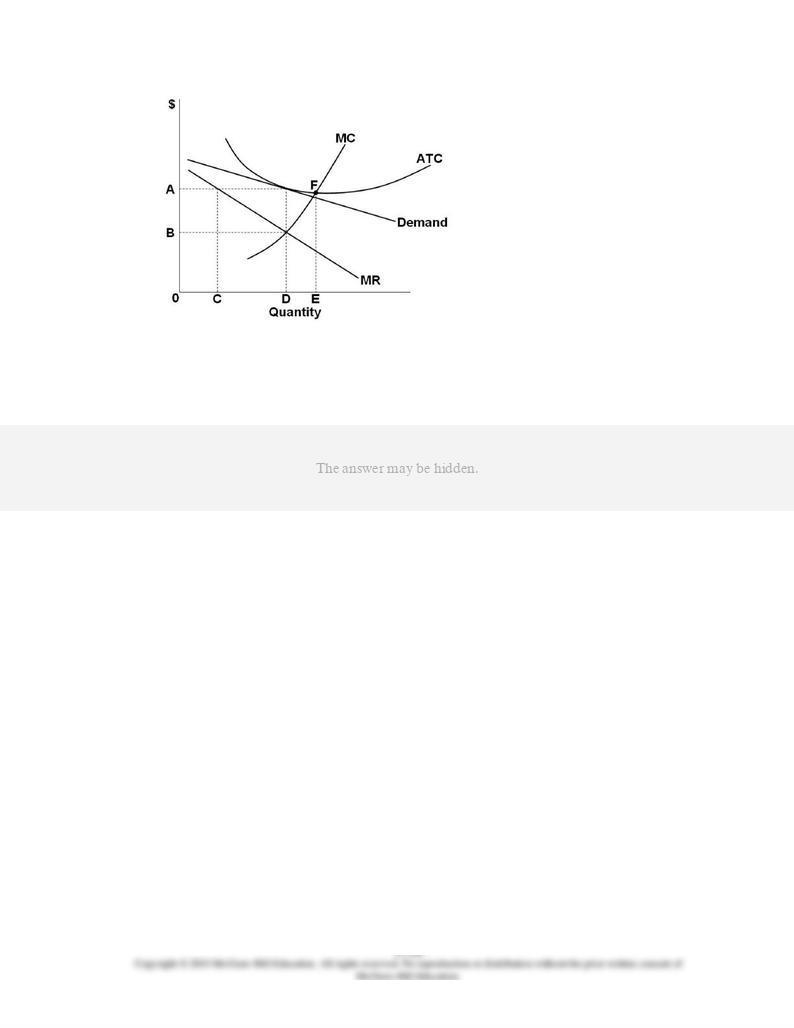
46.
Refer to the diagram for a monopolistically competitive firm. Long-run equilibrium output
will be:
AACSB: Reflective Thinking
Blooms: Analyze
Difficulty: 3 Hard
Learning Objective: 13-02 Explain why monopolistic competitors earn only a normal profit in the long run.
Topic: Price and output in monopolistic competition
Type: Graph
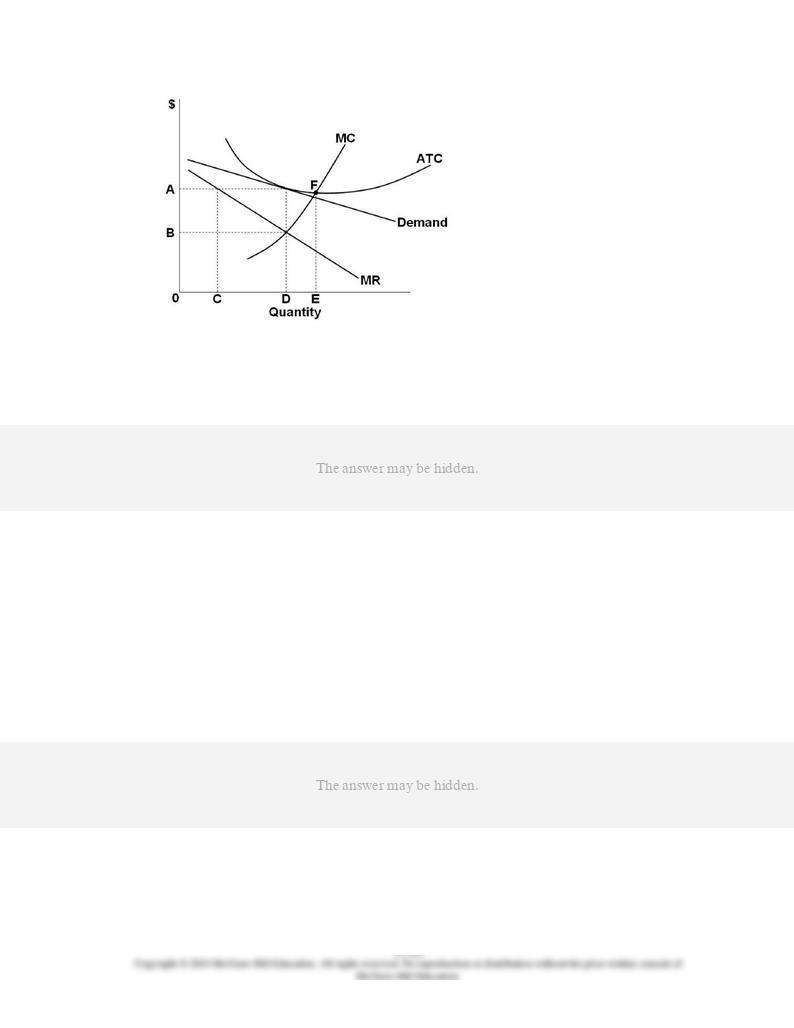
47.
Refer to the diagram for a monopolistically competitive firm. If more firms were to enter
the industry and product differentiation were to weaken, then:
AACSB: Reflective Thinking
Blooms: Analyze
Difficulty: 3 Hard
Learning Objective: 13-02 Explain why monopolistic competitors earn only a normal profit in the long run.
Topic: Price and output in monopolistic competition
Type: Graph
48.
Long-run equilibrium for a monopolistically competitive firm where economic profits are
zero results from:
AACSB: Reflective Thinking
Accessibility: Keyboard Navigation
Blooms: Understand
Difficulty: 2 Medium

Learning Objective: 13-02 Explain why monopolistic competitors earn only a normal profit in the long run.
Topic: Price and output in monopolistic competition
49.
When a monopolistically competitive firm is in long-run equilibrium:
AACSB: Reflective Thinking
Accessibility: Keyboard Navigation
Blooms: Understand
Difficulty: 2 Medium
Learning Objective: 13-02 Explain why monopolistic competitors earn only a normal profit in the long run.
Topic: Price and output in monopolistic competition
50.
If some firms leave a monopolistically competitive industry, the demand curves of the
remaining firms will:
AACSB: Reflective Thinking
Accessibility: Keyboard Navigation
Blooms: Analyze
Difficulty: 3 Hard
Learning Objective: 13-02 Explain why monopolistic competitors earn only a normal profit in the long run.
Topic: Price and output in monopolistic competition

51.
When a monopolistically competitive firm is in long-run equilibrium:
AACSB: Reflective Thinking
Accessibility: Keyboard Navigation
Blooms: Understand
Difficulty: 2 Medium
Learning Objective: 13-02 Explain why monopolistic competitors earn only a normal profit in the long run.
Topic: Price and output in monopolistic competition
52.
Other things equal, if more firms enter a monopolistically competitive industry:
AACSB: Reflective Thinking
Accessibility: Keyboard Navigation
Blooms: Analyze
Difficulty: 3 Hard
Learning Objective: 13-02 Explain why monopolistic competitors earn only a normal profit in the long run.
Topic: Price and output in monopolistic competition

53.
Which of the following statements is
correct
?
AACSB: Reflective Thinking
Accessibility: Keyboard Navigation
Blooms: Understand
Difficulty: 2 Medium
Learning Objective: 13-02 Explain why monopolistic competitors earn only a normal profit in the long run.
Topic: Price and output in monopolistic competition
54.
For a monopolistically competitive firm in long-run equilibrium:
AACSB: Reflective Thinking
Accessibility: Keyboard Navigation
Blooms: Understand
Difficulty: 2 Medium
Learning Objective: 13-02 Explain why monopolistic competitors earn only a normal profit in the long run.
Topic: Price and output in monopolistic competition

55.
In long-run equilibrium, both purely competitive and monopolistically competitive firms
will:
AACSB: Reflective Thinking
Accessibility: Keyboard Navigation
Blooms: Understand
Difficulty: 2 Medium
Learning Objective: 13-02 Explain why monopolistic competitors earn only a normal profit in the long run.
Topic: Price and output in monopolistic competition
56.
In long-run equilibrium, monopolistic competition entails:
AACSB: Reflective Thinking
Accessibility: Keyboard Navigation
Blooms: Understand
Difficulty: 2 Medium
Learning Objective: 13-03 Explain why monopolistic competition delivers neither productive nor allocative efficiency.
Topic: Monopolistic competition and efficiency

57.
Which of the following statements concerning a monopolistically competitive industry is
correct
?
AACSB: Reflective Thinking
Accessibility: Keyboard Navigation
Blooms: Analyze
Difficulty: 3 Hard
Learning Objective: 13-02 Explain why monopolistic competitors earn only a normal profit in the long run.
Topic: Price and output in monopolistic competition
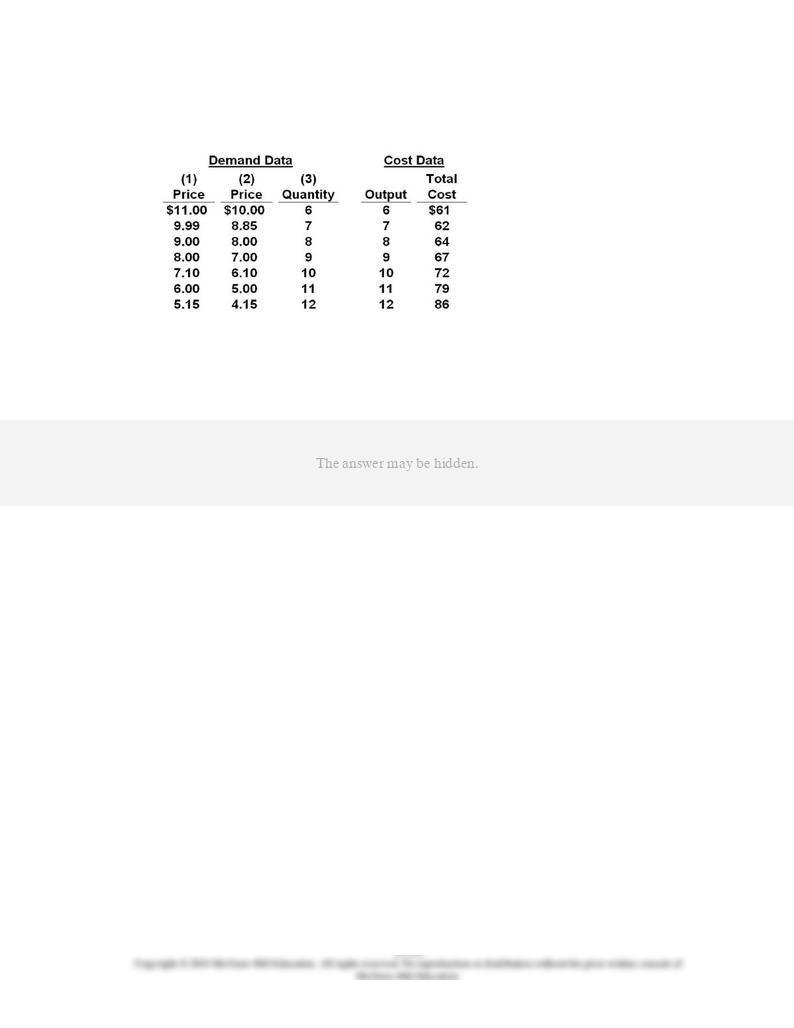
58.
Answer the question on the basis of the following demand and cost data for a specific
firm:
Refer to the data. If columns (1) and (3) of the demand data shown are this firm's demand
schedule, the profit-maximizing level of output will be:
AACSB: Analytic
Blooms: Analyze
Difficulty: 3 Hard
Learning Objective: 13-02 Explain why monopolistic competitors earn only a normal profit in the long run.
Topic: Price and output in monopolistic competition
Type: Table
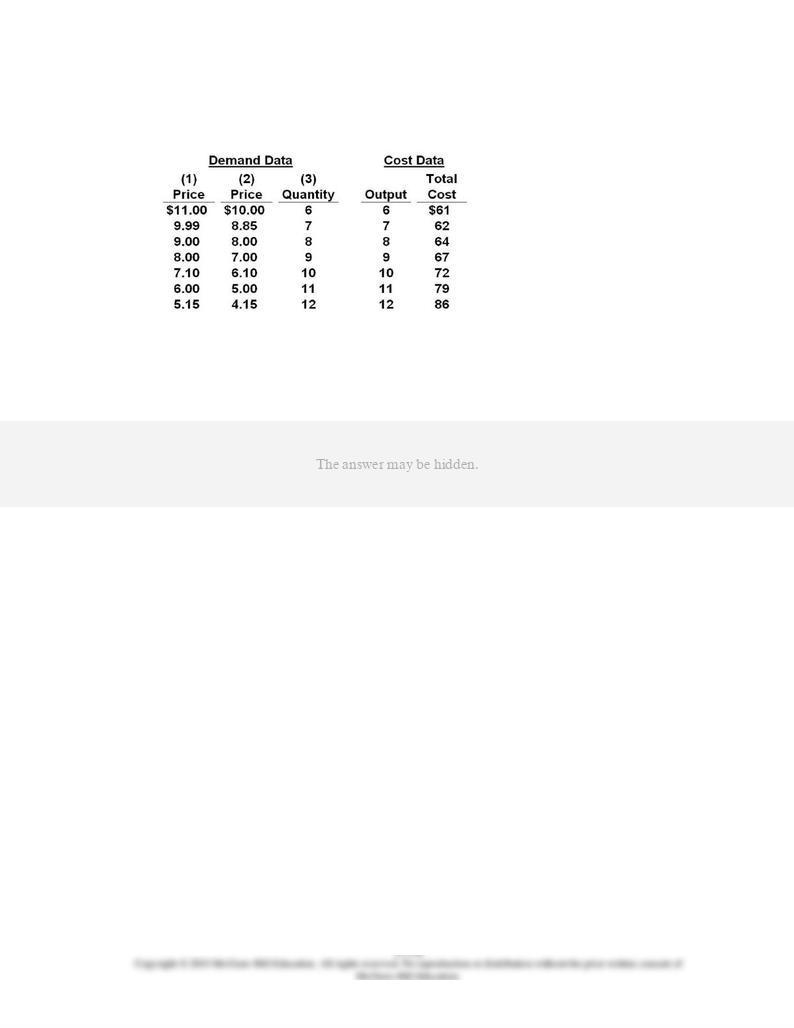
59.
Answer the question on the basis of the following demand and cost data for a specific
firm:
Refer to the data. If columns (1) and (3) of the demand data shown are this firm's demand
schedule, the profit-maximizing price will be:
AACSB: Analytic
Blooms: Analyze
Difficulty: 3 Hard
Learning Objective: 13-02 Explain why monopolistic competitors earn only a normal profit in the long run.
Topic: Price and output in monopolistic competition
Type: Table
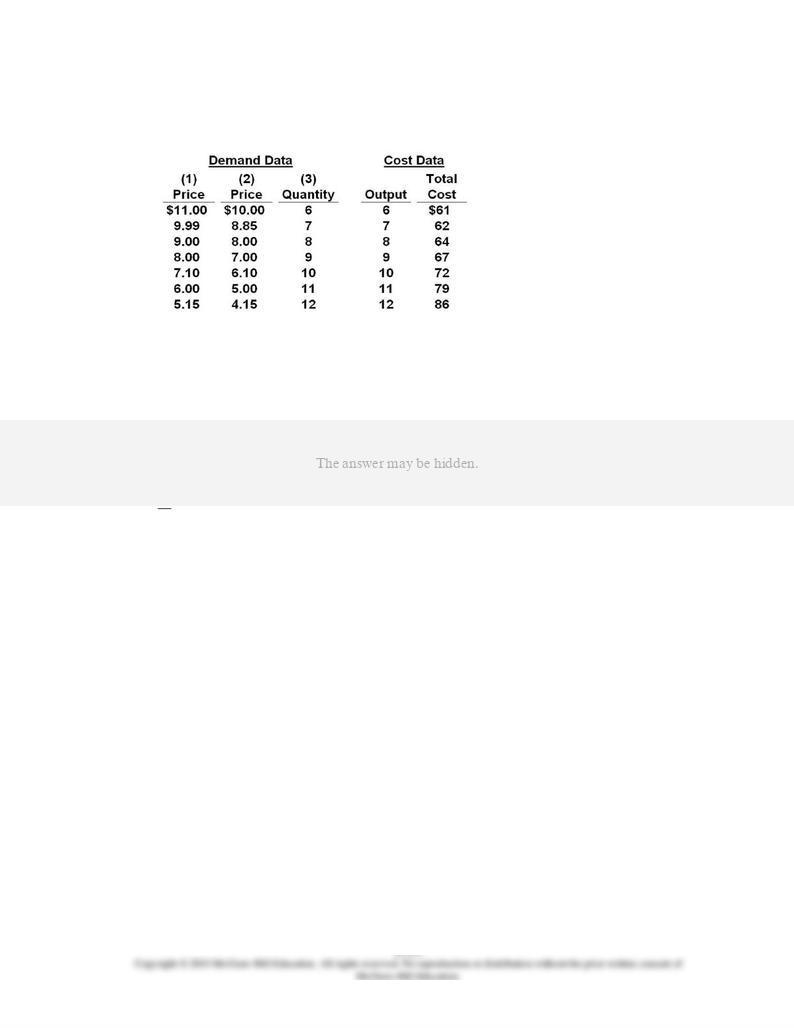
60.
Answer the question on the basis of the following demand and cost data for a specific
firm:
Refer to the data. If columns (1) and (3) of the demand data shown are this firm's demand
schedule, economic profit will be:
AACSB: Analytic
Blooms: Analyze
Difficulty: 3 Hard
Learning Objective: 13-02 Explain why monopolistic competitors earn only a normal profit in the long run.
Topic: Price and output in monopolistic competition
Type: Table
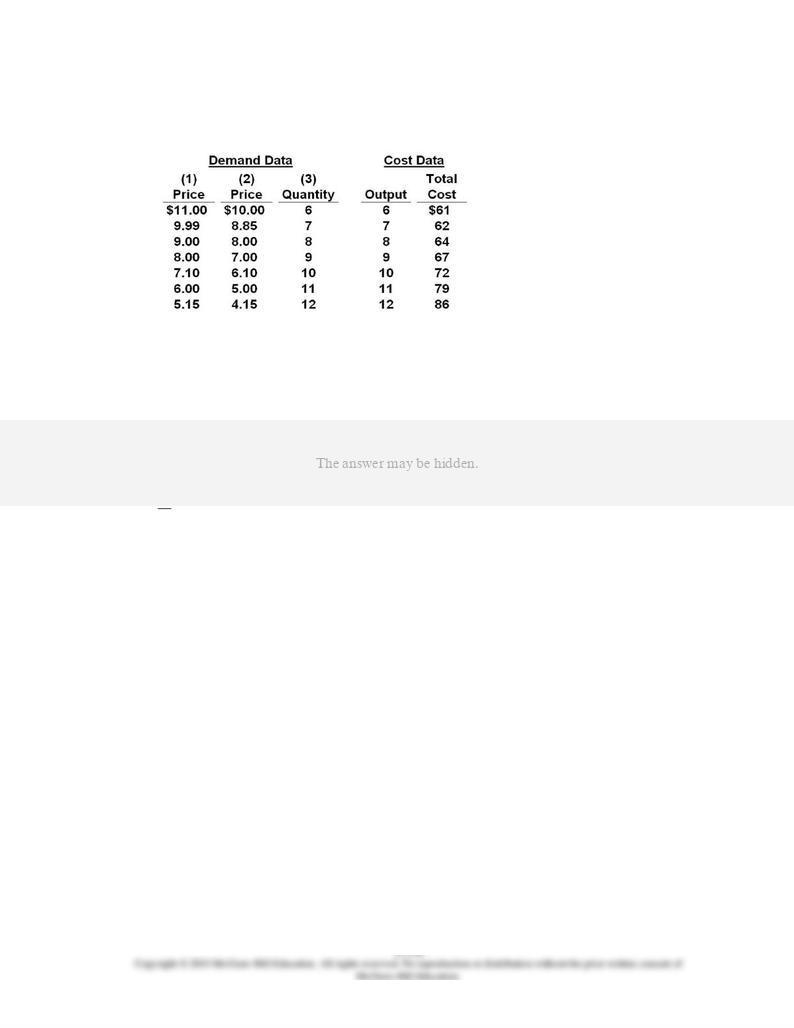
61.
Answer the question on the basis of the following demand and cost data for a specific
firm:
Refer to the data. Suppose that entry into the industry changes this firm's demand
schedule from columns (1) and (3) shown to columns (2) and (3). Economic profit will:
AACSB: Analytic
Blooms: Analyze
Difficulty: 3 Hard
Learning Objective: 13-02 Explain why monopolistic competitors earn only a normal profit in the long run.
Topic: Price and output in monopolistic competition
Type: Table
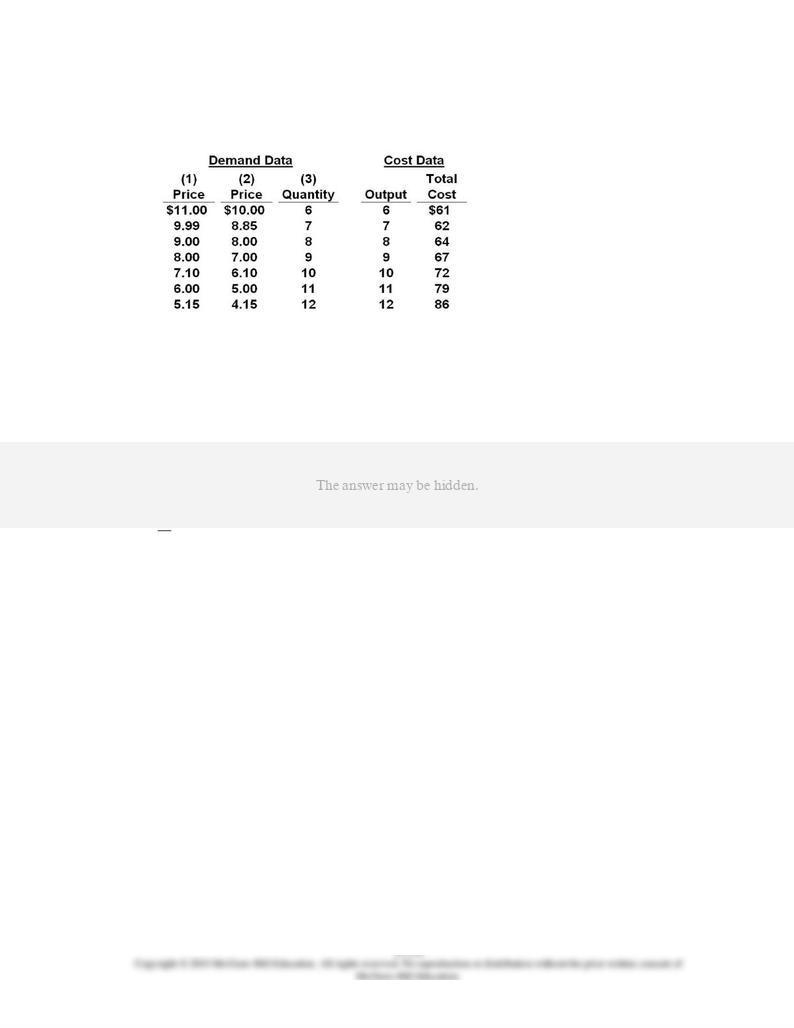
62.
Answer the question on the basis of the following demand and cost data for a specific
firm:
Refer to the data. Suppose that entry into this industry changes this firm's demand
schedule from columns (1) and (3) shown to columns (2) and (3). We can conclude that
this industry is:
AACSB: Analytic
Blooms: Analyze
Difficulty: 3 Hard
Learning Objective: 13-02 Explain why monopolistic competitors earn only a normal profit in the long run.
Topic: Price and output in monopolistic competition
Type: Table
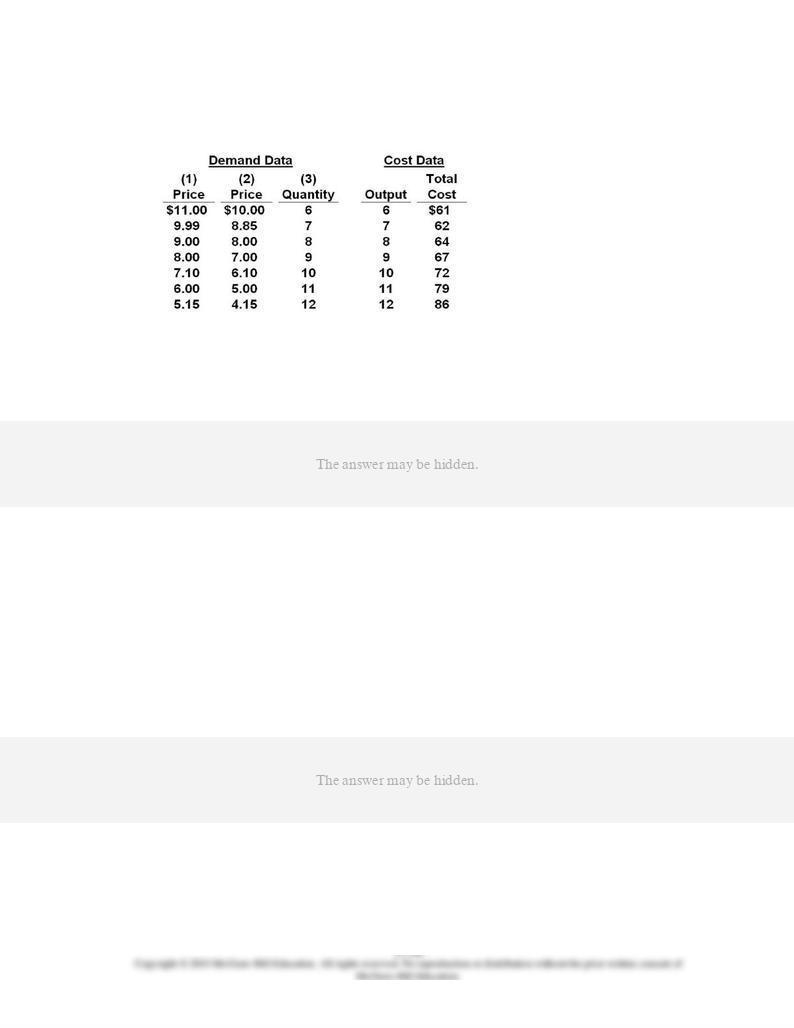
63.
Answer the question on the basis of the following demand and cost data for a specific
firm:
Refer to the data. With the demand schedule shown by columns (2) and (3), in long-run
equilibrium:
AACSB: Analytic
Blooms: Analyze
Difficulty: 3 Hard
Learning Objective: 13-02 Explain why monopolistic competitors earn only a normal profit in the long run.
Topic: Price and output in monopolistic competition
Type: Table
64.
An important similarity between a monopolistically competitive firm and a purely
competitive firm is that:
AACSB: Reflective Thinking
Accessibility: Keyboard Navigation
Blooms: Understand
Difficulty: 2 Medium

Learning Objective: 13-02 Explain why monopolistic competitors earn only a normal profit in the long run.
Topic: Price and output in monopolistic competition
65.
An important similarity between a monopolistically competitive firm and a pure monopolist
is that both:
AACSB: Reflective Thinking
Accessibility: Keyboard Navigation
Blooms: Understand
Difficulty: 2 Medium
Learning Objective: 13-02 Explain why monopolistic competitors earn only a normal profit in the long run.
Topic: Price and output in monopolistic competition
66.
The less elastic a monopolistic competitor's long-run demand curve, the:
AACSB: Reflective Thinking
Accessibility: Keyboard Navigation
Blooms: Analyze
Difficulty: 3 Hard
Learning Objective: 13-02 Explain why monopolistic competitors earn only a normal profit in the long run.
Topic: Price and output in monopolistic competition

67.
Refer to the diagram for a monopolistically competitive producer. The firm is:
AACSB: Reflective Thinking
Blooms: Understand
Difficulty: 2 Medium
Learning Objective: 13-02 Explain why monopolistic competitors earn only a normal profit in the long run.
Topic: Price and output in monopolistic competition
Type: Graph
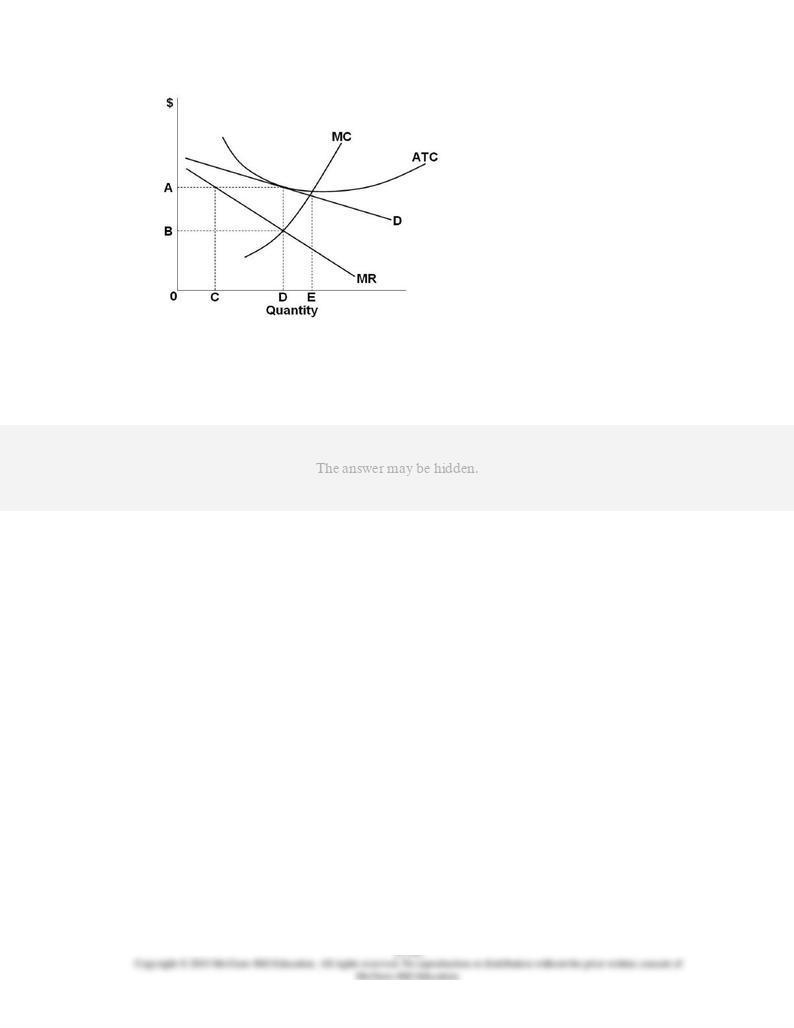
68.
Refer to the diagram for a monopolistically competitive producer. This firm is
experiencing:
AACSB: Reflective Thinking
Blooms: Analyze
Difficulty: 3 Hard
Learning Objective: 13-03 Explain why monopolistic competition delivers neither productive nor allocative efficiency.
Topic: Monopolistic competition and efficiency
Type: Graph
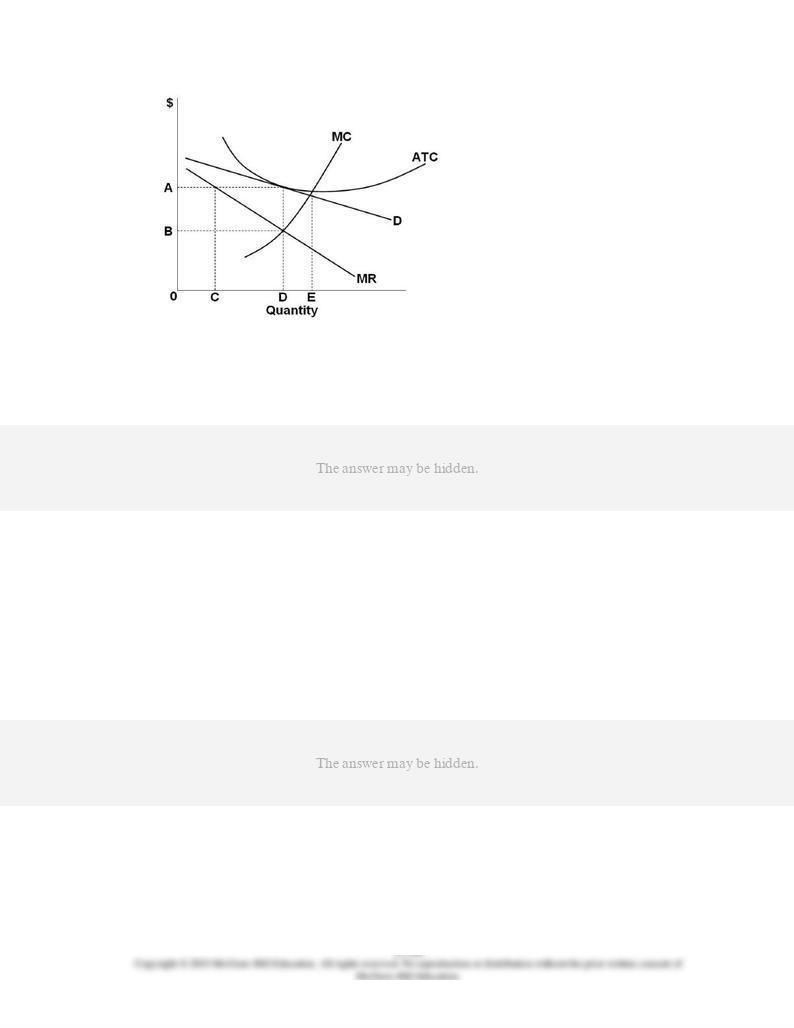
69.
Refer to the diagram for a monopolistically competitive producer. If this firm were to
realize productive efficiency, it would:
AACSB: Reflective Thinking
Blooms: Analyze
Difficulty: 3 Hard
Learning Objective: 13-03 Explain why monopolistic competition delivers neither productive nor allocative efficiency.
Topic: Monopolistic competition and efficiency
Type: Graph
70.
In the long run a monopolistically competitive firm:
AACSB: Reflective Thinking
Accessibility: Keyboard Navigation
Blooms: Understand
Difficulty: 2 Medium
Learning Objective: 13-02 Explain why monopolistic competitors earn only a normal profit in the long run.

Topic: Price and output in monopolistic competition
71.
Monopolistically competitive industries are inefficient because:
AACSB: Reflective Thinking
Accessibility: Keyboard Navigation
Blooms: Understand
Difficulty: 2 Medium
Learning Objective: 13-03 Explain why monopolistic competition delivers neither productive nor allocative efficiency.
Topic: Monopolistic competition and efficiency
72.
The economic inefficiencies of monopolistic competition may be offset by the fact that:
AACSB: Reflective Thinking
Accessibility: Keyboard Navigation
Blooms: Understand
Difficulty: 2 Medium
Learning Objective: 13-04 Relate how the ability of monopolistic competition to deliver product differentiation helps to
compensate for its failure to deliver economic efficiency.
Topic: Product variety
73.
A significant benefit of monopolistic competition compared with pure competition is:
AACSB: Reflective Thinking

Accessibility: Keyboard Navigation
Blooms: Understand
Difficulty: 2 Medium
Learning Objective: 13-04 Relate how the ability of monopolistic competition to deliver product differentiation helps to
compensate for its failure to deliver economic efficiency.
Topic: Product variety
74.
Product variety is likely to be greater in:
AACSB: Reflective Thinking
Accessibility: Keyboard Navigation
Blooms: Understand
Difficulty: 2 Medium
Learning Objective: 13-04 Relate how the ability of monopolistic competition to deliver product differentiation helps to
compensate for its failure to deliver economic efficiency.
Topic: Product variety
75.
Which of the following is
correct
?
AACSB: Reflective Thinking
Accessibility: Keyboard Navigation
Blooms: Understand
Difficulty: 2 Medium
Learning Objective: 13-04 Relate how the ability of monopolistic competition to deliver product differentiation helps to
compensate for its failure to deliver economic efficiency.
Topic: Product variety

76.
In monopolistically competitive markets, resources are:
AACSB: Reflective Thinking
Accessibility: Keyboard Navigation
Blooms: Understand
Difficulty: 2 Medium
Learning Objective: 13-03 Explain why monopolistic competition delivers neither productive nor allocative efficiency.
Topic: Monopolistic competition and efficiency
77.
In long-run equilibrium, a monopolistically competitive producer achieves:
AACSB: Reflective Thinking
Accessibility: Keyboard Navigation
Blooms: Understand
Difficulty: 2 Medium
Learning Objective: 13-03 Explain why monopolistic competition delivers neither productive nor allocative efficiency.
Topic: Monopolistic competition and efficiency
78.
The less elastic a monopolistic competitor's long-run demand curve, the:
AACSB: Reflective Thinking

Accessibility: Keyboard Navigation
Blooms: Understand
Difficulty: 2 Medium
Learning Objective: 13-04 Relate how the ability of monopolistic competition to deliver product differentiation helps to
compensate for its failure to deliver economic efficiency.
Topic: Product variety
79.
The more elastic a monopolistic competitor's long-run demand curve, the:
AACSB: Reflective Thinking
Accessibility: Keyboard Navigation
Blooms: Understand
Difficulty: 2 Medium
Learning Objective: 13-03 Explain why monopolistic competition delivers neither productive nor allocative efficiency.
Topic: Monopolistic competition and efficiency
80.
In which of these continuums of degrees of competition (highest to lowest) is oligopoly
properly placed?
AACSB: Analytic
Accessibility: Keyboard Navigation
Blooms: Remember
Difficulty: 1 Easy
Learning Objective: 13-05 Describe the characteristics of oligopoly.
Topic: Oligopoly: characteristics
Topic: Oligopoly: definition

81.
The term
oligopoly
indicates:
AACSB: Analytic
Accessibility: Keyboard Navigation
Blooms: Remember
Difficulty: 1 Easy
Learning Objective: 13-05 Describe the characteristics of oligopoly.
Topic: Oligopoly: characteristics
Topic: Oligopoly: definition
82.
In an oligopolistic market:
AACSB: Analytic
Accessibility: Keyboard Navigation
Blooms: Remember
Difficulty: 1 Easy
Learning Objective: 13-05 Describe the characteristics of oligopoly.
Topic: Oligopoly: characteristics
Topic: Oligopoly: definition
83.
Oligopolistic industries are characterized by:
AACSB: Analytic
Accessibility: Keyboard Navigation

Blooms: Remember
Difficulty: 1 Easy
Learning Objective: 13-05 Describe the characteristics of oligopoly.
Topic: Oligopoly: characteristics
Topic: Oligopoly: definition
84.
The automobile, household appliance, and automobile tire industries are all illustrations
of:
AACSB: Reflective Thinking
Accessibility: Keyboard Navigation
Blooms: Apply
Difficulty: 2 Medium
Learning Objective: 13-05 Describe the characteristics of oligopoly.
Topic: Oligopoly: characteristics
Topic: Oligopoly: definition
85.
Use your basic knowledge and your understanding of market structures to answer this
question. Which of the following companies most closely approximates a differentiated
oligopolist in a highly concentrated industry?
AACSB: Reflective Thinking
Accessibility: Keyboard Navigation
Blooms: Apply
Difficulty: 2 Medium
Learning Objective: 13-05 Describe the characteristics of oligopoly.
Topic: Oligopoly: characteristics
Topic: Oligopoly: definition

86.
Use your basic knowledge and your understanding of market structures to answer this
question. Which of the following companies most closely approximates a homogeneous
oligopolist in a highly concentrated industry?
AACSB: Reflective Thinking
Accessibility: Keyboard Navigation
Blooms: Apply
Difficulty: 2 Medium
Learning Objective: 13-05 Describe the characteristics of oligopoly.
Topic: Oligopoly: characteristics
Topic: Oligopoly: definition
87.
The mutual interdependence that characterizes oligopoly arises because:
AACSB: Reflective Thinking
Accessibility: Keyboard Navigation
Blooms: Understand
Difficulty: 2 Medium
Learning Objective: 13-05 Describe the characteristics of oligopoly.
Topic: Oligopoly: characteristics
Topic: Oligopoly: definition

88.
The copper, aluminum, cement, and industrial alcohol industries are examples of:
AACSB: Reflective Thinking
Accessibility: Keyboard Navigation
Blooms: Apply
Difficulty: 2 Medium
Learning Objective: 13-05 Describe the characteristics of oligopoly.
Topic: Oligopoly: characteristics
Topic: Oligopoly: definition
89.
Which of the following is the best example of oligopoly?
AACSB: Reflective Thinking
Accessibility: Keyboard Navigation
Blooms: Apply
Difficulty: 2 Medium
Learning Objective: 13-05 Describe the characteristics of oligopoly.
Topic: Oligopoly: characteristics
Topic: Oligopoly: definition
90.
If there are significant economies of scale in an industry, then:
AACSB: Reflective Thinking
Accessibility: Keyboard Navigation

Blooms: Understand
Difficulty: 2 Medium
Learning Objective: 13-05 Describe the characteristics of oligopoly.
Topic: Oligopoly: characteristics
Topic: Oligopoly: definition
91.
In which of the following market models do demand and marginal revenue diverge?
AACSB: Reflective Thinking
Accessibility: Keyboard Navigation
Blooms: Understand
Difficulty: 2 Medium
Learning Objective: 13-05 Describe the characteristics of oligopoly.
Topic: Oligopoly: characteristics
Topic: Oligopoly: definition
92.
Oligopoly is more difficult to analyze than other market models because:
AACSB: Reflective Thinking
Accessibility: Keyboard Navigation
Blooms: Understand
Difficulty: 2 Medium
Learning Objective: 13-05 Describe the characteristics of oligopoly.
Topic: Oligopoly: characteristics
Topic: Oligopoly: definition

93.
Which of the following is an illustration of
differentiated
oligopoly?
AACSB: Reflective Thinking
Accessibility: Keyboard Navigation
Blooms: Apply
Difficulty: 2 Medium
Learning Objective: 13-05 Describe the characteristics of oligopoly.
Topic: Oligopoly: characteristics
Topic: Oligopoly: definition
94.
Which of the following industries is an illustration of
homogeneous
oligopoly?
AACSB: Reflective Thinking
Accessibility: Keyboard Navigation
Blooms: Apply
Difficulty: 2 Medium
Learning Objective: 13-05 Describe the characteristics of oligopoly.
Topic: Oligopoly: characteristics
Topic: Oligopoly: definition
95.
Differentiated oligopoly exists where a small number of firms are:
AACSB: Analytic
Accessibility: Keyboard Navigation

Blooms: Remember
Difficulty: 1 Easy
Learning Objective: 13-05 Describe the characteristics of oligopoly.
Topic: Oligopoly: characteristics
Topic: Oligopoly: definition
96.
Homogeneous oligopoly exists where a small number of firms are:
AACSB: Analytic
Accessibility: Keyboard Navigation
Blooms: Remember
Difficulty: 1 Easy
Learning Objective: 13-05 Describe the characteristics of oligopoly.
Topic: Oligopoly: characteristics
Topic: Oligopoly: definition
97.
Which of the following is a unique feature of oligopoly?
AACSB: Analytic
Accessibility: Keyboard Navigation
Blooms: Remember
Difficulty: 1 Easy
Learning Objective: 13-05 Describe the characteristics of oligopoly.
Topic: Oligopoly: characteristics
Topic: Oligopoly: definition

98.
Prices are likely to be least flexible:
AACSB: Reflective Thinking
Accessibility: Keyboard Navigation
Blooms: Understand
Difficulty: 2 Medium
Learning Objective: 13-05 Describe the characteristics of oligopoly.
Topic: Oligopoly: characteristics
Topic: Oligopoly: definition
99.
Mutual interdependence means that each oligopolistic firm:
AACSB: Analytic
Accessibility: Keyboard Navigation
Blooms: Remember
Difficulty: 1 Easy
Learning Objective: 13-05 Describe the characteristics of oligopoly.
Topic: Oligopoly: characteristics
Topic: Oligopoly: definition
100.
Clear-cut mutual interdependence with respect to the price-output policies exists in:
AACSB: Analytic
Accessibility: Keyboard Navigation

Blooms: Remember
Difficulty: 1 Easy
Learning Objective: 13-05 Describe the characteristics of oligopoly.
Topic: Oligopoly: characteristics
Topic: Oligopoly: definition
101.
Concentration ratios measure the:
AACSB: Analytic
Accessibility: Keyboard Navigation
Blooms: Remember
Difficulty: 1 Easy
Learning Objective: 13-05 Describe the characteristics of oligopoly.
Topic: Oligopoly: characteristics
Topic: Oligopoly: definition
102.
If the four-firm concentration ratio for industry X is 80:
AACSB: Reflective Thinking
Accessibility: Keyboard Navigation
Blooms: Apply
Difficulty: 2 Medium
Learning Objective: 13-05 Describe the characteristics of oligopoly.
Topic: Oligopoly: characteristics
Topic: Oligopoly: definition

103.
An industry having a four-firm concentration ratio of 85 percent:
AACSB: Reflective Thinking
Accessibility: Keyboard Navigation
Blooms: Apply
Difficulty: 2 Medium
Learning Objective: 13-05 Describe the characteristics of oligopoly.
Topic: Oligopoly: characteristics
Topic: Oligopoly: definition
104.
As a general rule, oligopoly exists when the four-firm concentration ratio:
AACSB: Reflective Thinking
Accessibility: Keyboard Navigation
Blooms: Understand
Difficulty: 2 Medium
Learning Objective: 13-05 Describe the characteristics of oligopoly.
Topic: Oligopoly: characteristics
Topic: Oligopoly: definition
105.
Aluminum competes with copper in the market for power transmission lines. This
illustrates:
AACSB: Reflective Thinking

Accessibility: Keyboard Navigation
Blooms: Apply
Difficulty: 2 Medium
Learning Objective: 13-05 Describe the characteristics of oligopoly.
Topic: Oligopoly: characteristics
Topic: Oligopoly: definition
106.
The Herfindahl index for a pure monopolist is:
D.
10.
AACSB: Analytic
Accessibility: Keyboard Navigation
Blooms: Remember
Difficulty: 1 Easy
Learning Objective: 13-05 Describe the characteristics of oligopoly.
Topic: Oligopoly: characteristics
Topic: Oligopoly: definition
107.
Industries X and Y both have four-firm concentration ratios of 65 percent, but the
Herfindahl index for X is 1,500 while that for Y is 2,000. These data suggest:
AACSB: Reflective Thinking
Accessibility: Keyboard Navigation
Blooms: Apply
Difficulty: 2 Medium
Learning Objective: 13-05 Describe the characteristics of oligopoly.
Topic: Oligopoly: characteristics
Topic: Oligopoly: definition

108.
Suppose that total sales in an industry in a particular year are $600 million and sales by
the top four sellers are $200 million, $150 million, $100 million, and $50 million,
respectively. We can conclude that:
AACSB: Analytic
Accessibility: Keyboard Navigation
Blooms: Apply
Difficulty: 2 Medium
Learning Objective: 13-05 Describe the characteristics of oligopoly.
Topic: Oligopoly: characteristics
Topic: Oligopoly: definition
109.
The four-firm sales concentration ratio for an industry measures the:
AACSB: Analytic
Accessibility: Keyboard Navigation
Blooms: Remember
Difficulty: 1 Easy
Learning Objective: 13-05 Describe the characteristics of oligopoly.
Topic: Oligopoly: characteristics
Topic: Oligopoly: definition

110.
Concentration ratios:
AACSB: Reflective Thinking
Accessibility: Keyboard Navigation
Blooms: Understand
Difficulty: 2 Medium
Learning Objective: 13-05 Describe the characteristics of oligopoly.
Topic: Oligopoly: characteristics
Topic: Oligopoly: definition
111.
If a product such as cement or bricks is costly to ship and, therefore, markets are very
localized, the national concentration ratio for that industry:
AACSB: Reflective Thinking
Accessibility: Keyboard Navigation
Blooms: Analyze
Difficulty: 3 Hard
Learning Objective: 13-05 Describe the characteristics of oligopoly.
Topic: Oligopoly: characteristics
Topic: Oligopoly: definition

112.
Concentration ratios may be inaccurate indicators of the degree of monopoly power in an
industry because:
AACSB: Reflective Thinking
Accessibility: Keyboard Navigation
Blooms: Understand
Difficulty: 2 Medium
Learning Objective: 13-05 Describe the characteristics of oligopoly.
Topic: Oligopoly: characteristics
Topic: Oligopoly: definition
113.
If an industry evolves from monopolistic competition to oligopoly, we would expect:
AACSB: Reflective Thinking
Accessibility: Keyboard Navigation
Blooms: Understand
Difficulty: 2 Medium
Learning Objective: 13-05 Describe the characteristics of oligopoly.
Topic: Oligopoly: characteristics
Topic: Oligopoly: definition

114.
Interindustry competition means that:
AACSB: Analytic
Accessibility: Keyboard Navigation
Blooms: Understand
Difficulty: 2 Medium
Learning Objective: 13-05 Describe the characteristics of oligopoly.
Topic: Oligopoly: characteristics
Topic: Oligopoly: definition
115.
If you sum the squares of the market shares of each firm in an industry (as measured by
percent of industry sales), you are calculating the:
AACSB: Analytic
Accessibility: Keyboard Navigation
Blooms: Remember
Difficulty: 1 Easy
Learning Objective: 13-05 Describe the characteristics of oligopoly.
Topic: Oligopoly: characteristics
Topic: Oligopoly: definition

116.
The Herfindahl index:
AACSB: Reflective Thinking
Accessibility: Keyboard Navigation
Blooms: Understand
Difficulty: 2 Medium
Learning Objective: 13-05 Describe the characteristics of oligopoly.
Topic: Oligopoly: characteristics
Topic: Oligopoly: definition
117.
If the four-firm concentration ratio in an oligopolistic industry is 100 percent and each firm
has an equal percentage of sales, the Herfindahl index is:
AACSB: Analytic
Accessibility: Keyboard Navigation
Blooms: Apply
Difficulty: 2 Medium
Learning Objective: 13-05 Describe the characteristics of oligopoly.
Topic: Oligopoly: characteristics
Topic: Oligopoly: definition

118.
Assume six firms comprising an industry have market shares of 30, 30, 10, 10, 10, and 10
percent. The Herfindahl index for this industry is:
D.
80.
AACSB: Analytic
Accessibility: Keyboard Navigation
Blooms: Apply
Difficulty: 2 Medium
Learning Objective: 13-05 Describe the characteristics of oligopoly.
Topic: Oligopoly: characteristics
Topic: Oligopoly: definition
119.
Suppose the Herfindahl indexes for industries A, B, and C are 1,200, 5,000, and 7,500
respectively. These data imply that:
AACSB: Analytic
Accessibility: Keyboard Navigation
Blooms: Apply
Difficulty: 2 Medium
Learning Objective: 13-05 Describe the characteristics of oligopoly.
Topic: Oligopoly: characteristics
Topic: Oligopoly: definition

120.
Refer to the data. The industry characterized by the information is:
AACSB: Analytic
Blooms: Apply
Difficulty: 2 Medium
Learning Objective: 13-05 Describe the characteristics of oligopoly.
Topic: Oligopoly: characteristics
Topic: Oligopoly: definition
Type: Table
121.
Refer to the data. The four-firm concentration ratio for the industry is:
AACSB: Analytic
Blooms: Apply
Difficulty: 2 Medium
Learning Objective: 13-05 Describe the characteristics of oligopoly.
Topic: Oligopoly: characteristics

Topic: Oligopoly: definition
Type: Table
122.
Refer to the data. The Herfindahl index for the industry is:
D.
80.
AACSB: Analytic
Blooms: Apply
Difficulty: 2 Medium
Learning Objective: 13-05 Describe the characteristics of oligopoly.
Topic: Oligopoly: characteristics
Topic: Oligopoly: definition
Type: Table

123.
AACSB: Analytic
Blooms: Apply
Difficulty: 2 Medium
Learning Objective: 13-05 Describe the characteristics of oligopoly.
Topic: Oligopoly: characteristics
Topic: Oligopoly: definition
Type: Table
124.
Refer to the data. Suppose that firms in this industry split up such that there were 100
firms, each with a one percent market share. The four-firm concentration ratio and the
Herfindahl index respectively would be:
AACSB: Analytic
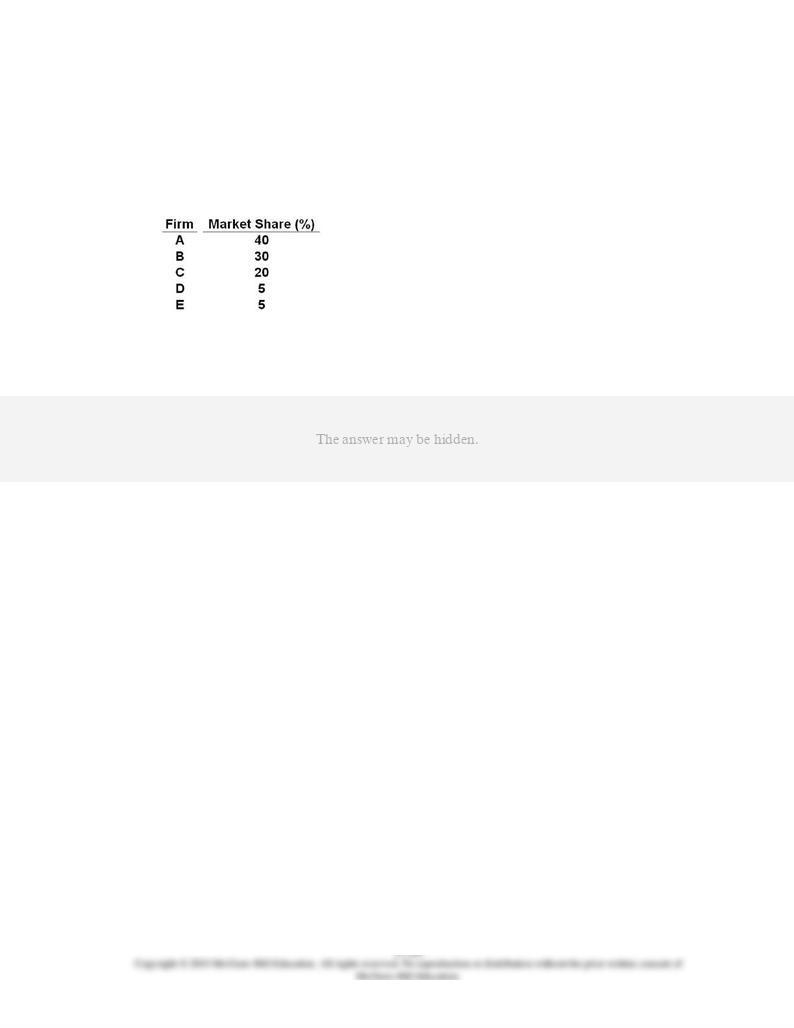
Blooms: Apply
Difficulty: 2 Medium
Learning Objective: 13-05 Describe the characteristics of oligopoly.
Topic: Oligopoly: characteristics
Topic: Oligopoly: definition
Type: Table
125.
Refer to the data. The four-firm concentration ratio for this industry is:
AACSB: Analytic
Blooms: Apply
Difficulty: 2 Medium
Learning Objective: 13-05 Describe the characteristics of oligopoly.
Topic: Oligopoly: characteristics
Topic: Oligopoly: definition
Type: Table

126.
AACSB: Analytic
Blooms: Apply
Difficulty: 2 Medium
Learning Objective: 13-05 Describe the characteristics of oligopoly.
Topic: Oligopoly: characteristics
Topic: Oligopoly: definition
Type: Table
127.
Refer to the data. This industry illustrates:
AACSB: Analytic
Blooms: Apply
Difficulty: 2 Medium
Learning Objective: 13-05 Describe the characteristics of oligopoly.
Topic: Oligopoly: characteristics
Topic: Oligopoly: definition

Type: Table
128.
Refer to the data. If Firm B merged with Firm C, the industry's four-firm concentration
ratio would ____ and its Herfindahl index would ____.
AACSB: Analytic
Blooms: Apply
Difficulty: 2 Medium
Learning Objective: 13-05 Describe the characteristics of oligopoly.
Topic: Oligopoly: characteristics
Topic: Oligopoly: definition
Type: Table
129.
Game theory:
AACSB: Analytic
Accessibility: Keyboard Navigation
Blooms: Remember
Difficulty: 1 Easy
Learning Objective: 13-06 Discuss how game theory relates to oligopoly.
Topic: Oligopoly behavior: game-theory overview

130.
The study of how people (or firms) behave in strategic situations is called:
AACSB: Analytic
Accessibility: Keyboard Navigation
Blooms: Remember
Difficulty: 1 Easy
Learning Objective: 13-06 Discuss how game theory relates to oligopoly.
Topic: Oligopoly behavior: game-theory overview
131.
Game theory is best suited to analyze the pricing behavior of:
AACSB: Reflective Thinking
Accessibility: Keyboard Navigation
Blooms: Understand
Difficulty: 2 Medium
Learning Objective: 13-06 Discuss how game theory relates to oligopoly.
Topic: Oligopoly behavior: game-theory overview
132.
Game theory can be used to demonstrate that oligopolists:
AACSB: Reflective Thinking
Accessibility: Keyboard Navigation
Blooms: Understand
Difficulty: 2 Medium
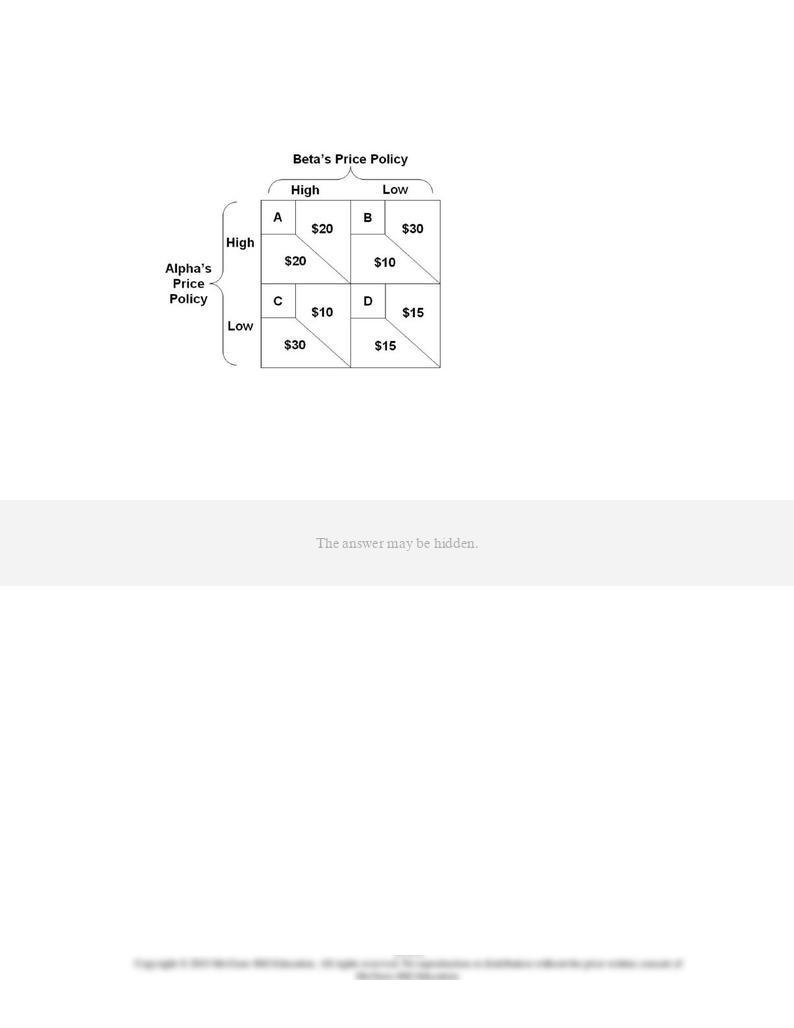
Learning Objective: 13-06 Discuss how game theory relates to oligopoly.
Topic: Oligopoly behavior: game-theory overview
133.
Refer to the diagram where the numerical data show profits in millions of dollars. Beta's
profits are shown in the northeast corner and Alpha's profits in the southwest corner of
each cell. If both firms follow a high-price policy:
AACSB: Analytic
Blooms: Apply
Difficulty: 2 Medium
Learning Objective: 13-06 Discuss how game theory relates to oligopoly.
Topic: Oligopoly behavior: game-theory overview
Type: Figure

134.
Refer to the diagram where the numerical data show profits in millions of dollars. Beta's
profits are shown in the northeast corner and Alpha's profits in the southwest corner of
each cell. If Beta commits to a high-price policy, Alpha will gain the largest profit by:
AACSB: Analytic
Blooms: Analyze
Difficulty: 3 Hard
Learning Objective: 13-06 Discuss how game theory relates to oligopoly.
Topic: Oligopoly behavior: game-theory overview
Type: Figure
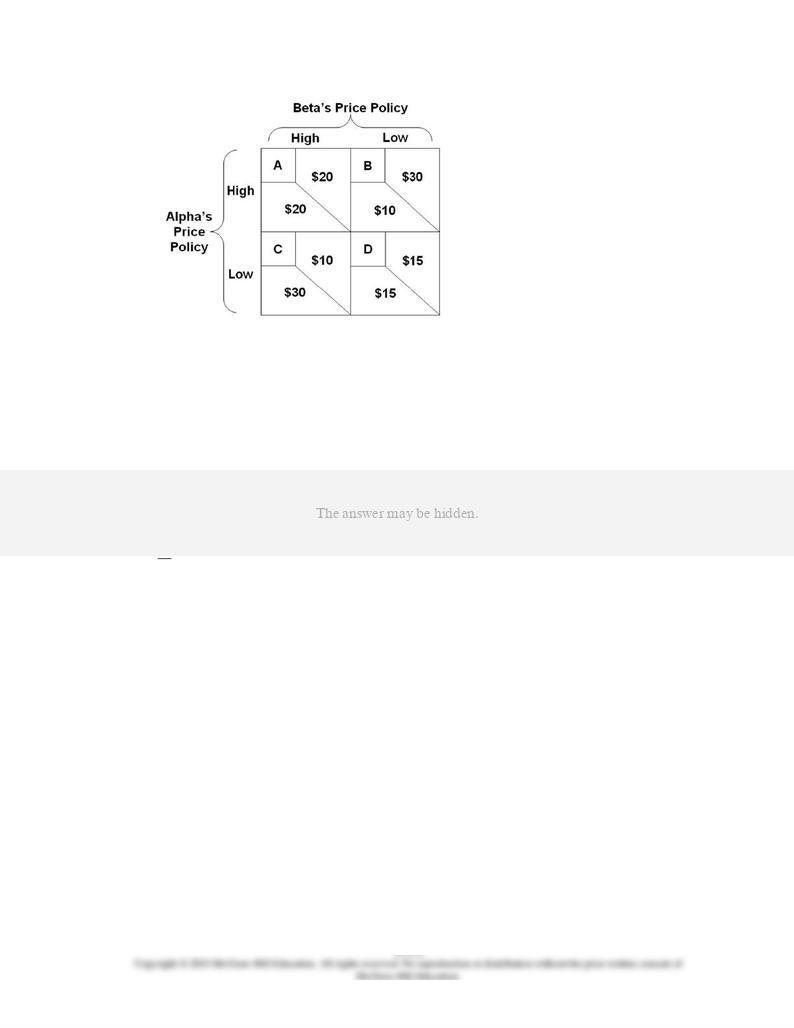
135.
Refer to the diagram where the numerical data show profits in millions of dollars. Beta's
profits are shown in the northeast corner and Alpha's profits in the southwest corner of
each cell. With independent pricing, the outcome of this duopoly game will gravitate to
cell:
AACSB: Analytic
Blooms: Analyze
Difficulty: 3 Hard
Learning Objective: 13-06 Discuss how game theory relates to oligopoly.
Topic: Oligopoly behavior: game-theory overview
Type: Figure
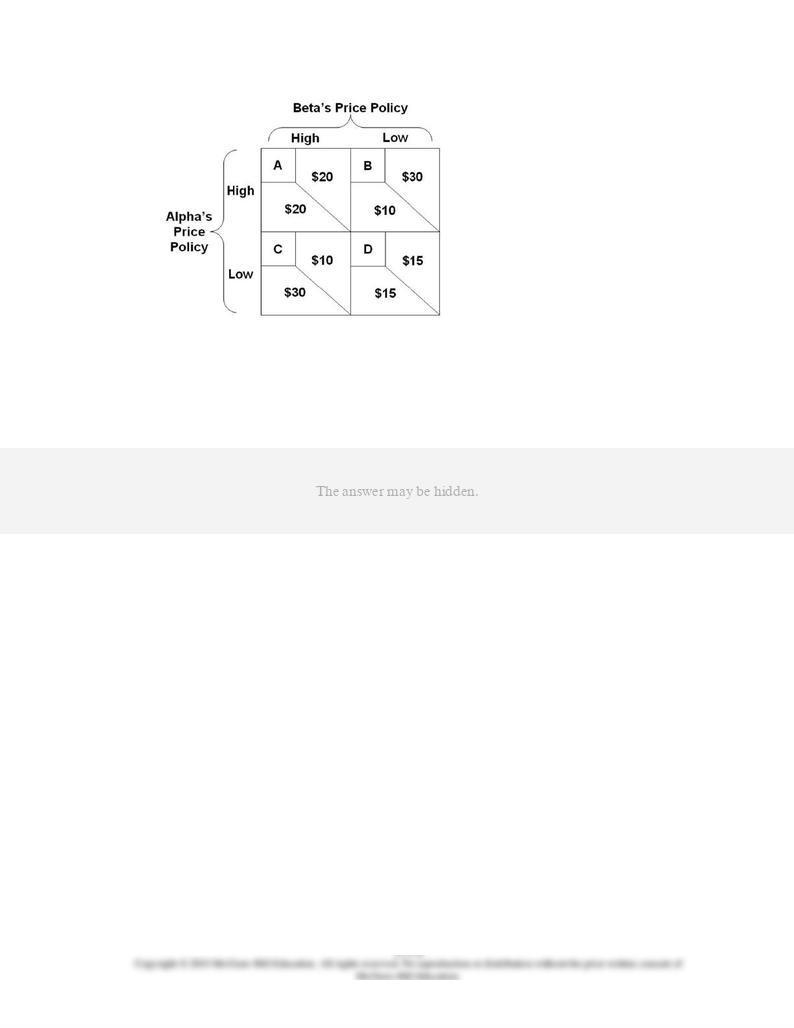
136.
Refer to the diagram where the numerical data show profits in millions of dollars. Beta's
profits are shown in the northeast corner and Alpha's profits in the southwest corner of
each cell. If Alpha and Beta engage in collusion, the outcome of the game will be at cell:
AACSB: Analytic
Blooms: Analyze
Difficulty: 3 Hard
Learning Objective: 13-06 Discuss how game theory relates to oligopoly.
Topic: Oligopoly behavior: game-theory overview
Type: Figure
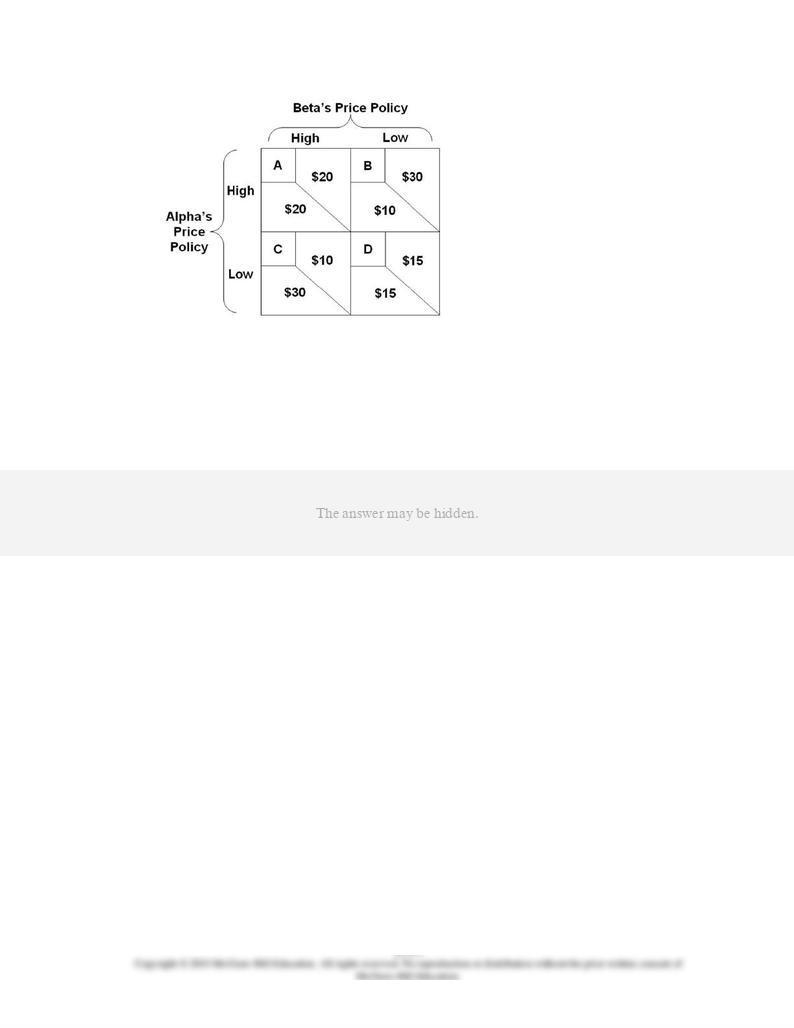
137.
Refer to the diagram where the numerical data show profits in millions of dollars. Beta's
profits are shown in the northeast corner and Alpha's profits in the southwest corner of
each cell. If Alpha and Beta agree to a high-price policy through collusion, the temptation
to cheat on that agreement is demonstrated by the fact that:
AACSB: Analytic
Blooms: Analyze
Difficulty: 3 Hard
Learning Objective: 13-06 Discuss how game theory relates to oligopoly.
Topic: Oligopoly behavior: game-theory overview
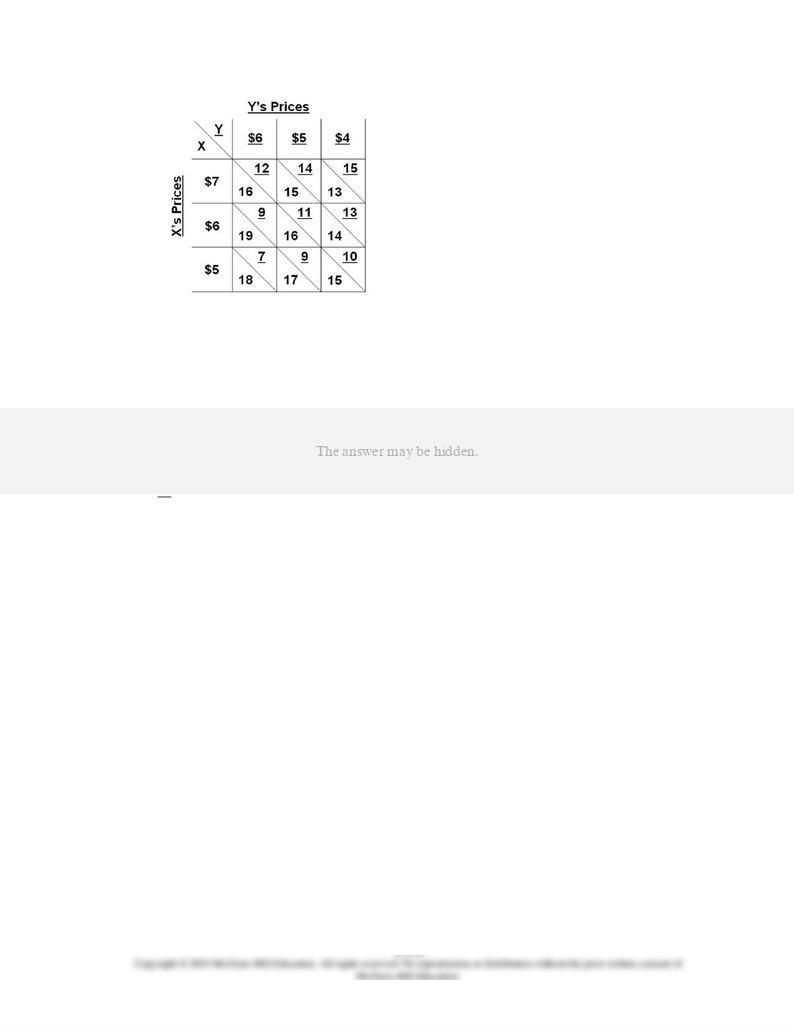
138.
Refer to the profits-payoff table for a duopoly. If the firms are acting independently and
firm X sets its price at $6, firm Y will achieve the largest profit by selecting:
AACSB: Analytic
Blooms: Analyze
Difficulty: 3 Hard
Learning Objective: 13-06 Discuss how game theory relates to oligopoly.
Topic: Oligopoly behavior: game-theory overview
Type: Figure
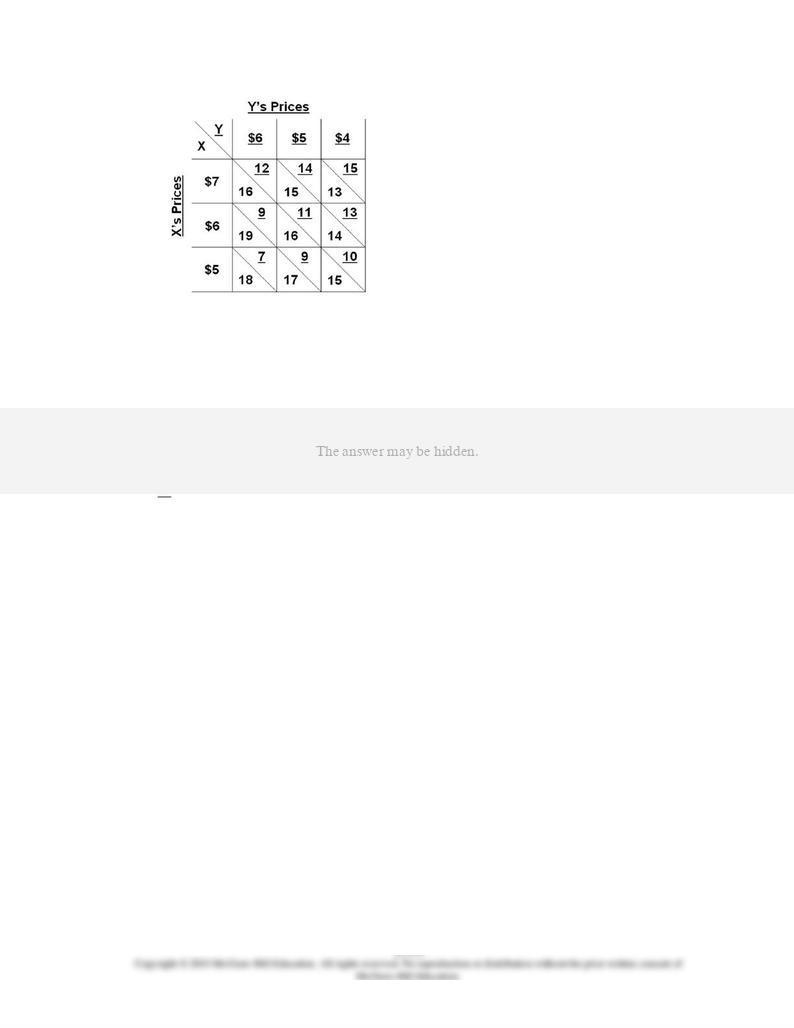
139.
Refer to the profits-payoff table for a duopoly. If initially firms X and Y are charging $5 and
$4 respectively:
AACSB: Analytic
Blooms: Analyze
Difficulty: 3 Hard
Learning Objective: 13-06 Discuss how game theory relates to oligopoly.
Topic: Oligopoly behavior: game-theory overview
Type: Figure
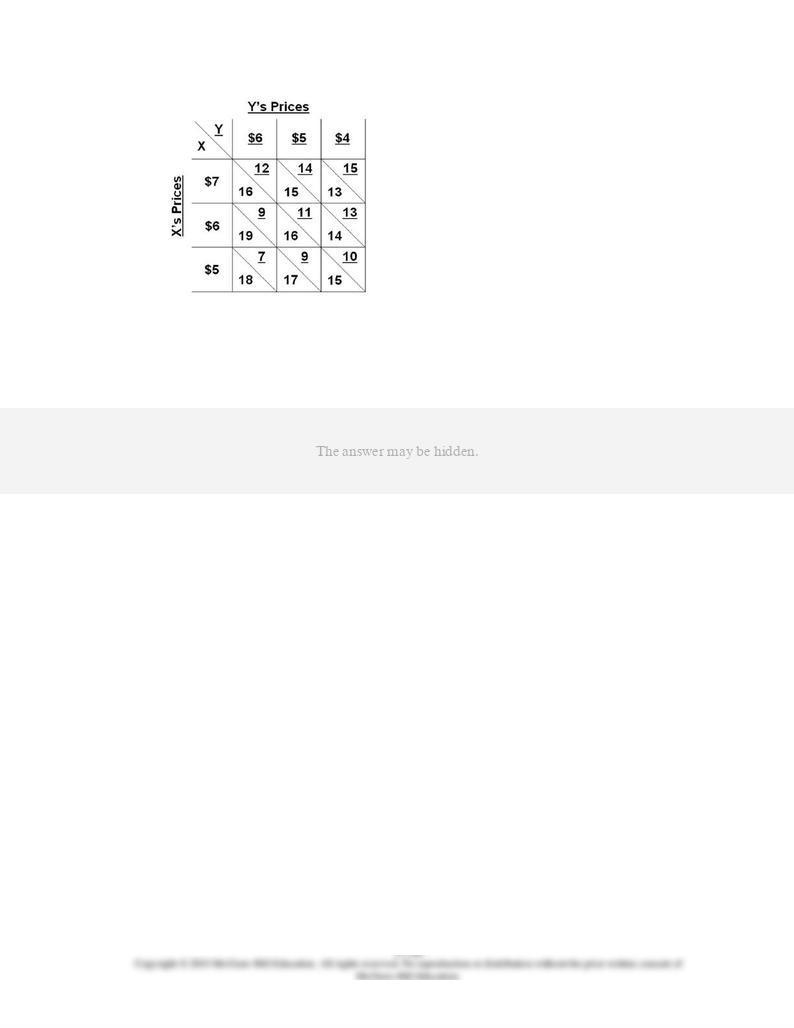
140.
Refer to the profits-payoff table for a duopoly. If initially firm X's price was $6 and Y's price
was $5:
AACSB: Analytic
Blooms: Analyze
Difficulty: 3 Hard
Learning Objective: 13-06 Discuss how game theory relates to oligopoly.
Topic: Oligopoly behavior: game-theory overview
Type: Figure
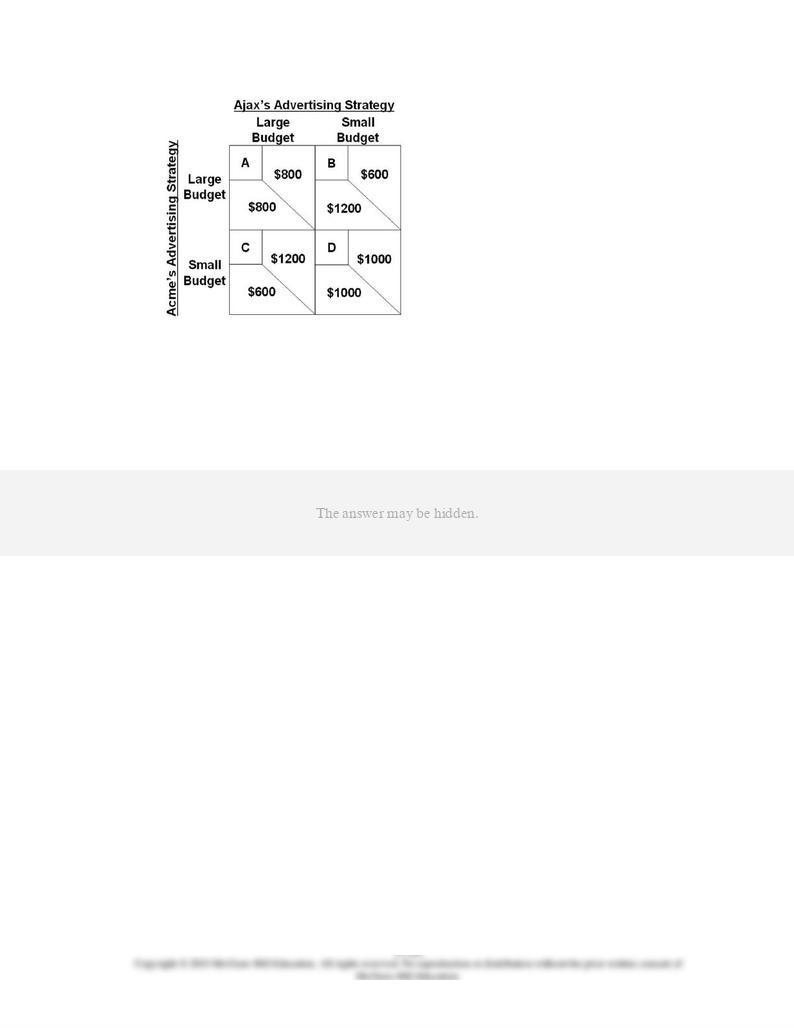
141.
Refer to the game theory matrix where the numerical data show the profits resulting from
alternative combinations of advertising strategies for Ajax and Acme. Ajax's profits are
shown in the upper right part of each cell; Acme's profits are shown in the lower left.
Without collusion, the outcome of the game is cell:
AACSB: Analytic
Blooms: Analyze
Difficulty: 3 Hard
Learning Objective: 13-06 Discuss how game theory relates to oligopoly.
Topic: Oligopoly behavior: game-theory overview
Type: Figure
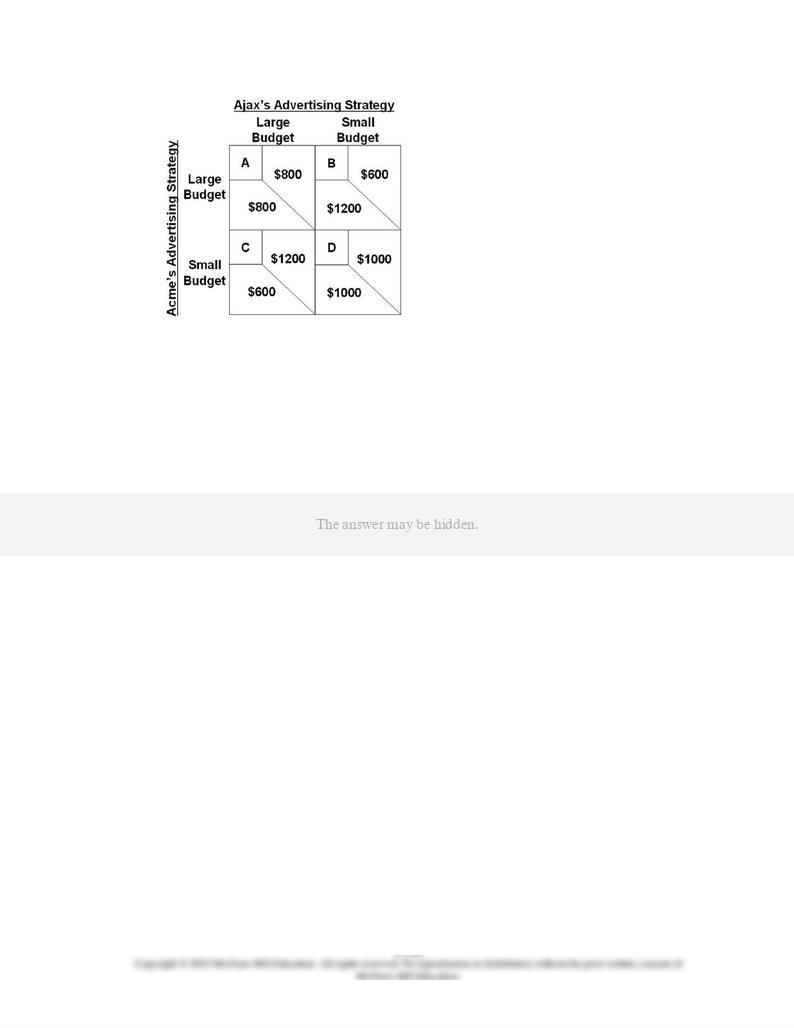
142.
Refer to the game theory matrix where the numerical data show the profits resulting from
alternative combinations of advertising strategies for Ajax and Acme. Ajax's profits are
shown in the upper right part of each cell; Acme's profits are shown in the lower left.
Without collusion, the outcome of the game:
A.
maximizes joint profits for the firms.
AACSB: Analytic
Blooms: Analyze
Difficulty: 3 Hard
Learning Objective: 13-06 Discuss how game theory relates to oligopoly.
Topic: Oligopoly behavior: game-theory overview
Type: Figure
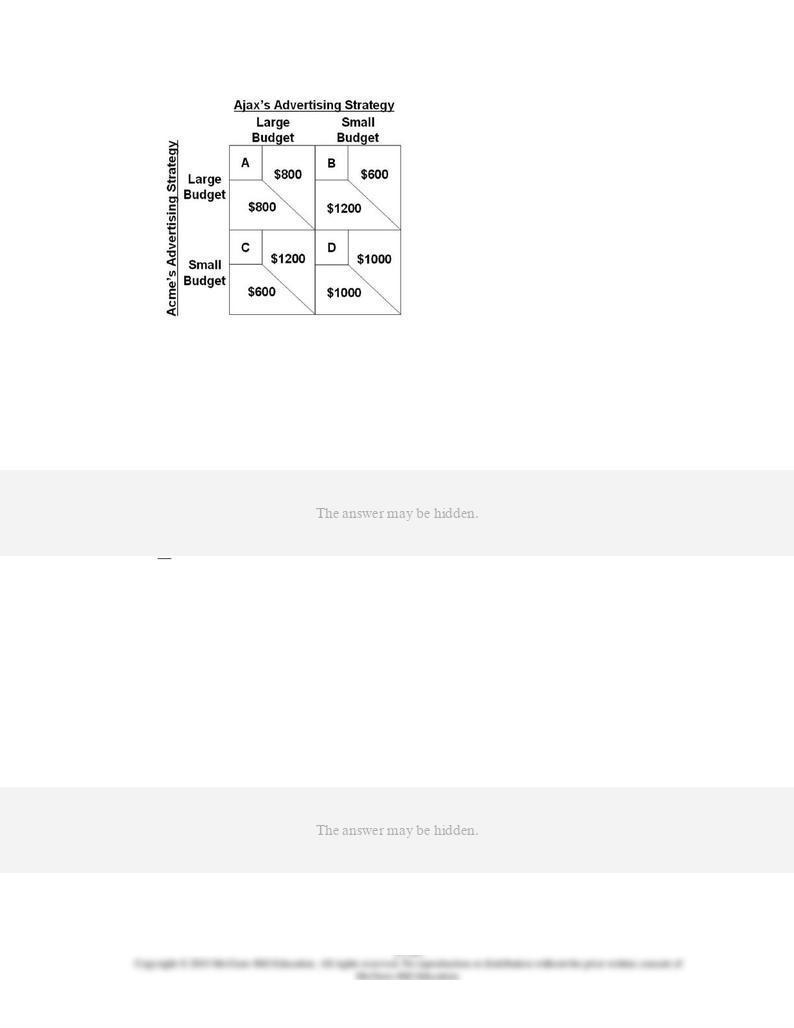
143.
Refer to the game theory matrix where the numerical data show the profits resulting from
alternative combinations of advertising strategies for Ajax and Acme. Ajax's profits are
shown in the upper right part of each cell; Acme's profits are shown in the lower left. With
collusion and no cheating, the outcome of the game is cell:
AACSB: Analytic
Blooms: Analyze
Difficulty: 3 Hard
Learning Objective: 13-06 Discuss how game theory relates to oligopoly.
Topic: Oligopoly behavior: game-theory overview
Type: Figure
144.
Suppose an oligopolistic producer assumes its rivals will ignore a price increase but match
a price cut. In this case the firm perceives its:
AACSB: Reflective Thinking
Accessibility: Keyboard Navigation

Blooms: Understand
Difficulty: 2 Medium
Learning Objective: 13-07 Explain the three main models of oligopoly pricing and output: kinked-demand theory; collusive
pricing; and price leadership.
Topic: Three oligopoly models: kinked-demand curve model
145.
The kinked-demand curve of an oligopolist is based on the assumption that:
AACSB: Reflective Thinking
Accessibility: Keyboard Navigation
Blooms: Remember
Difficulty: 1 Easy
Learning Objective: 13-07 Explain the three main models of oligopoly pricing and output: kinked-demand theory; collusive
pricing; and price leadership.
Topic: Three oligopoly models: kinked-demand curve model
146.
If an oligopoly is faced with a kinked-demand curve that is relatively elastic above, and
relatively inelastic below, the going price, then it will:
AACSB: Reflective Thinking
Accessibility: Keyboard Navigation
Blooms: Understand
Difficulty: 2 Medium
Learning Objective: 13-07 Explain the three main models of oligopoly pricing and output: kinked-demand theory; collusive
pricing; and price leadership.
Topic: Three oligopoly models: kinked-demand curve model

147.
The kinked-demand curve model of oligopoly is useful in explaining:
AACSB: Reflective Thinking
Accessibility: Keyboard Navigation
Blooms: Understand
Difficulty: 2 Medium
Learning Objective: 13-07 Explain the three main models of oligopoly pricing and output: kinked-demand theory; collusive
pricing; and price leadership.
Topic: Three oligopoly models: kinked-demand curve model
148.
The kinked-demand curve model helps to explain price rigidity because:
AACSB: Reflective Thinking
Accessibility: Keyboard Navigation
Blooms: Understand
Difficulty: 2 Medium
Learning Objective: 13-07 Explain the three main models of oligopoly pricing and output: kinked-demand theory; collusive
pricing; and price leadership.
Topic: Three oligopoly models: kinked-demand curve model

149.
If competing oligopolists completely ignore oligopolist X's price changes, then X's:
AACSB: Reflective Thinking
Accessibility: Keyboard Navigation
Blooms: Understand
Difficulty: 2 Medium
Learning Objective: 13-07 Explain the three main models of oligopoly pricing and output: kinked-demand theory; collusive
pricing; and price leadership.
Topic: Three oligopoly models: kinked-demand curve model
150.
If an oligopolist is faced with a marginal revenue curve that has a gap in it, we may
assume that:
AACSB: Reflective Thinking
Accessibility: Keyboard Navigation
Blooms: Understand
Difficulty: 2 Medium
Learning Objective: 13-07 Explain the three main models of oligopoly pricing and output: kinked-demand theory; collusive
pricing; and price leadership.
Topic: Three oligopoly models: kinked-demand curve model

151.
The kinked-demand curve model of oligopoly:
AACSB: Reflective Thinking
Accessibility: Keyboard Navigation
Blooms: Understand
Difficulty: 2 Medium
Learning Objective: 13-07 Explain the three main models of oligopoly pricing and output: kinked-demand theory; collusive
pricing; and price leadership.
Topic: Three oligopoly models: kinked-demand curve model

152.
Refer to the diagram for a noncollusive oligopolist. Suppose that the firm is initially in
equilibrium at point
E
, where the equilibrium price and quantity are
P
and
Q
. Which of the
following statements is correct?
AACSB: Reflective Thinking
Blooms: Understand
Difficulty: 2 Medium
Learning Objective: 13-07 Explain the three main models of oligopoly pricing and output: kinked-demand theory; collusive
pricing; and price leadership.
Topic: Three oligopoly models: kinked-demand curve model
Type: Graph
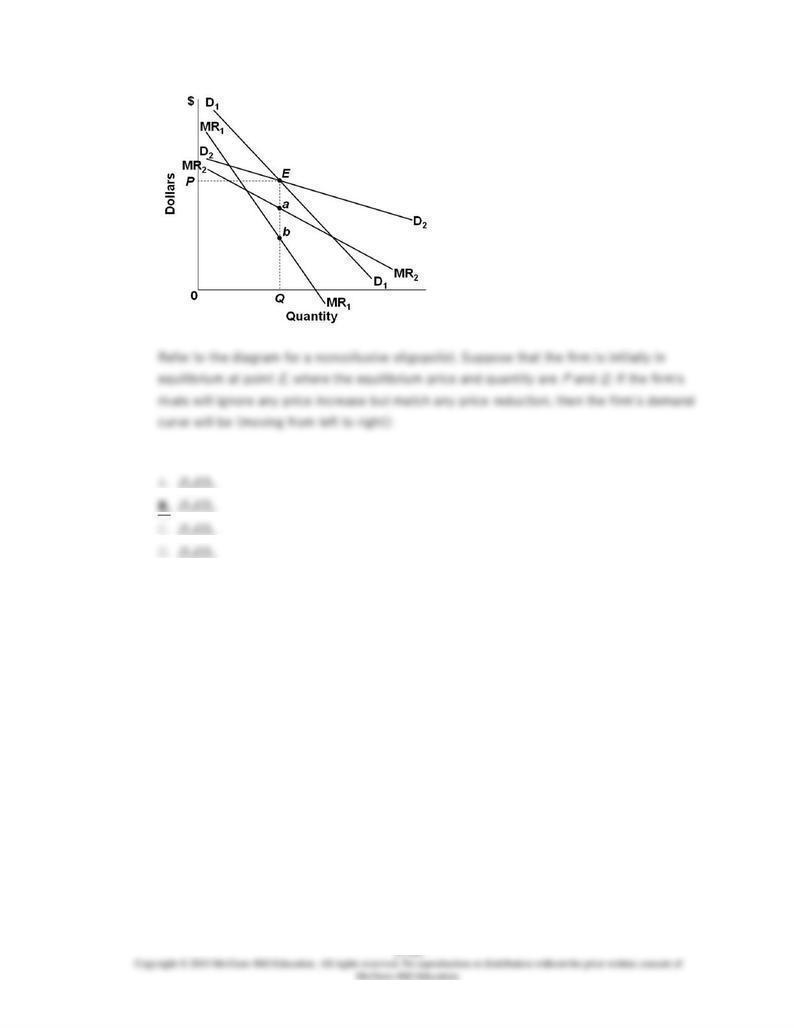
153.
1
2.
2
1.
1
1.
2
2.
AACSB: Reflective Thinking
Blooms: Understand
Difficulty: 2 Medium
Learning Objective: 13-07 Explain the three main models of oligopoly pricing and output: kinked-demand theory; collusive
pricing; and price leadership.
Topic: Three oligopoly models: kinked-demand curve model
Type: Graph
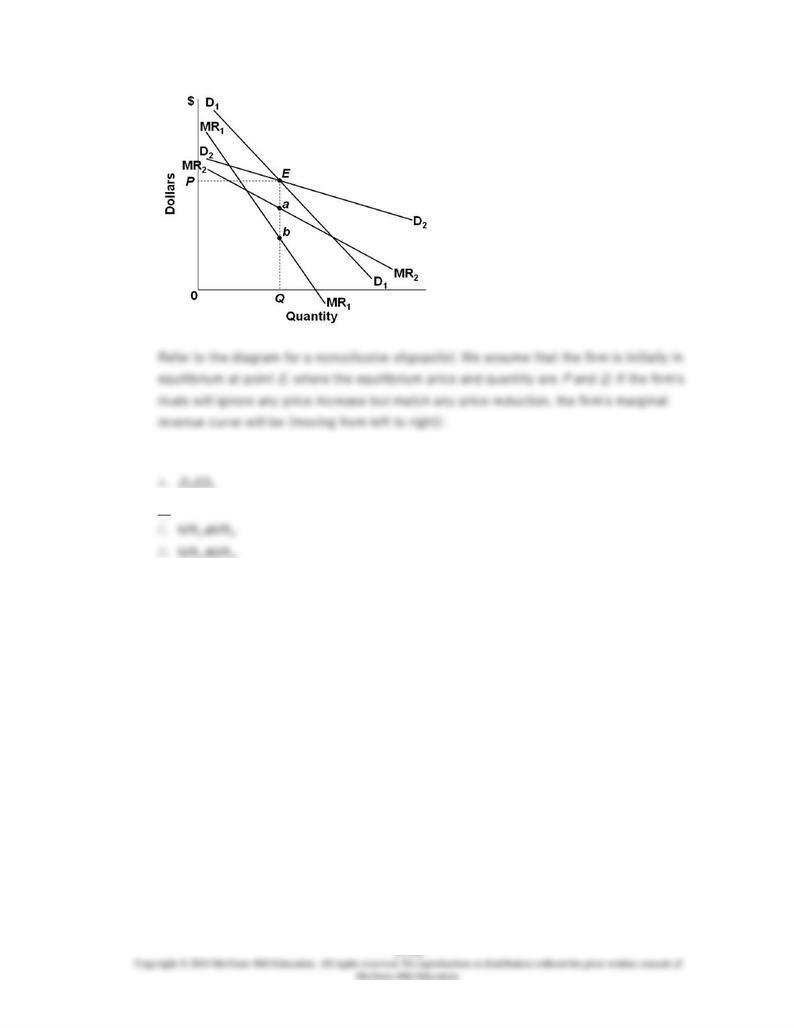
154.
1
2.
B.
MR2
ab
MR1.
AACSB: Reflective Thinking
Blooms: Understand
Difficulty: 2 Medium
Learning Objective: 13-07 Explain the three main models of oligopoly pricing and output: kinked-demand theory; collusive
pricing; and price leadership.
Topic: Three oligopoly models: kinked-demand curve model
Type: Graph
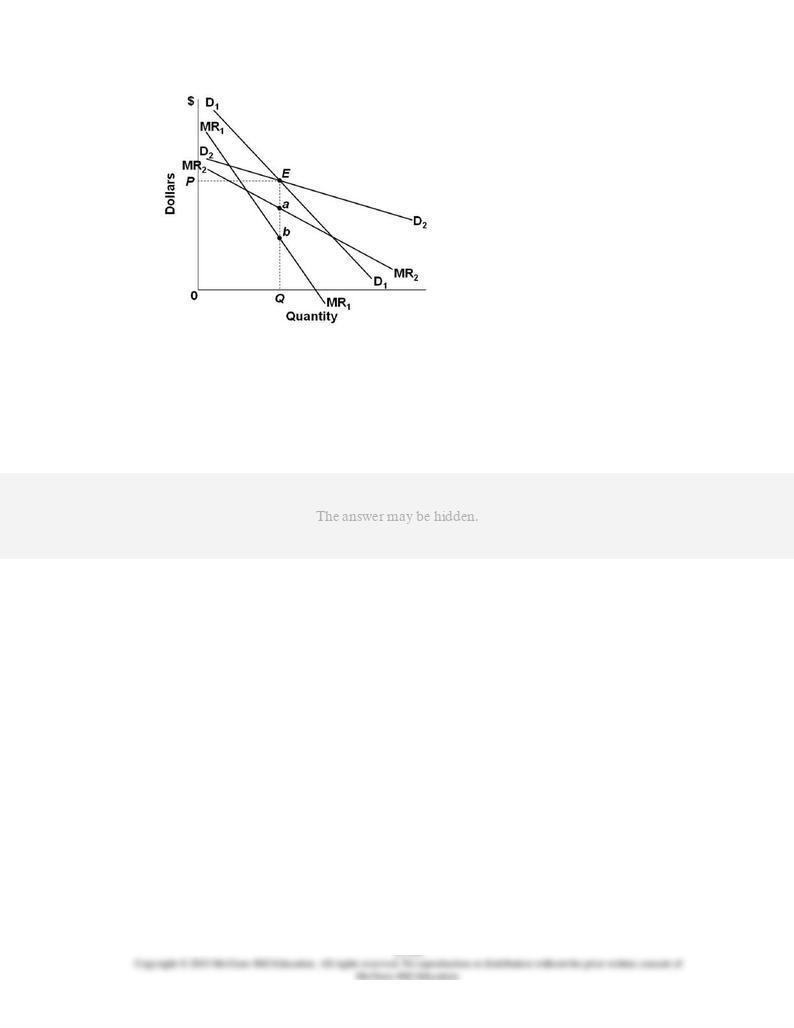
155.
Refer to the diagram for a noncollusive oligopolist. We assume that the firm is initially in
equilibrium at point
E
, where the equilibrium price and quantity are
P
and
Q
. If the firm's
rivals will ignore any price increase but match any price reduction, over what range might
marginal cost rise without disturbing equilibrium price and output?
AACSB: Reflective Thinking
Blooms: Analyze
Difficulty: 3 Hard
Learning Objective: 13-07 Explain the three main models of oligopoly pricing and output: kinked-demand theory; collusive
pricing; and price leadership.
Topic: Three oligopoly models: kinked-demand curve model
Type: Graph
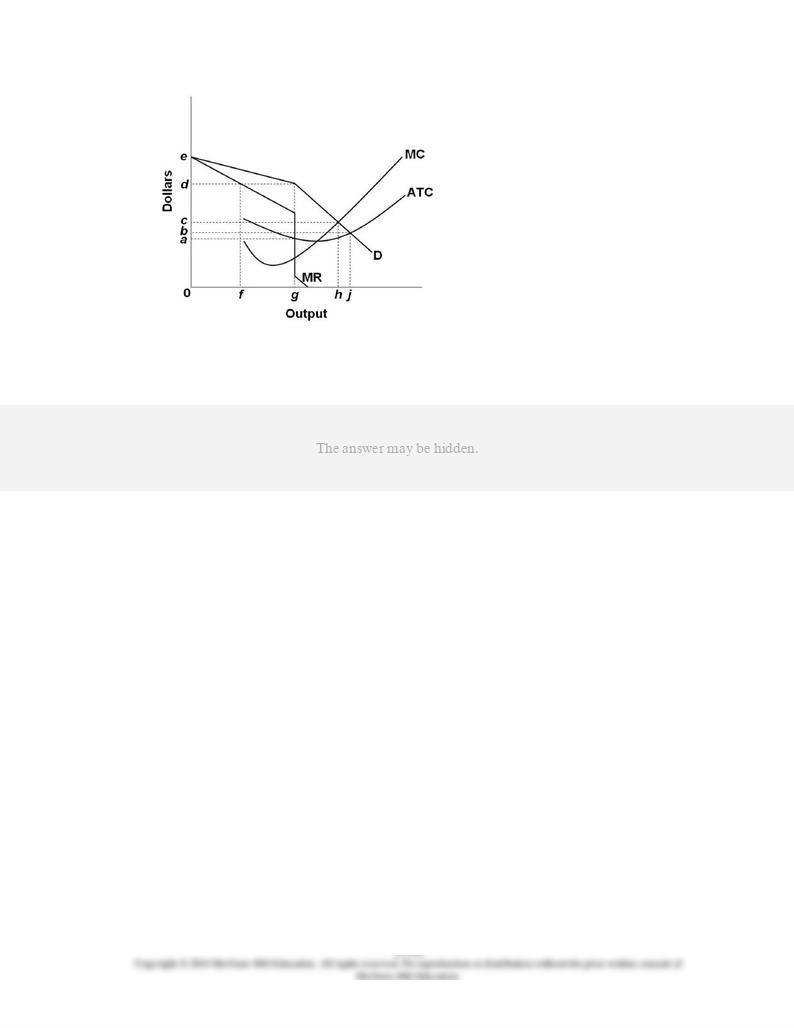
156.
The diagram portrays:
AACSB: Reflective Thinking
Blooms: Understand
Difficulty: 2 Medium
Learning Objective: 13-07 Explain the three main models of oligopoly pricing and output: kinked-demand theory; collusive
pricing; and price leadership.
Topic: Three oligopoly models: kinked-demand curve model
Type: Graph
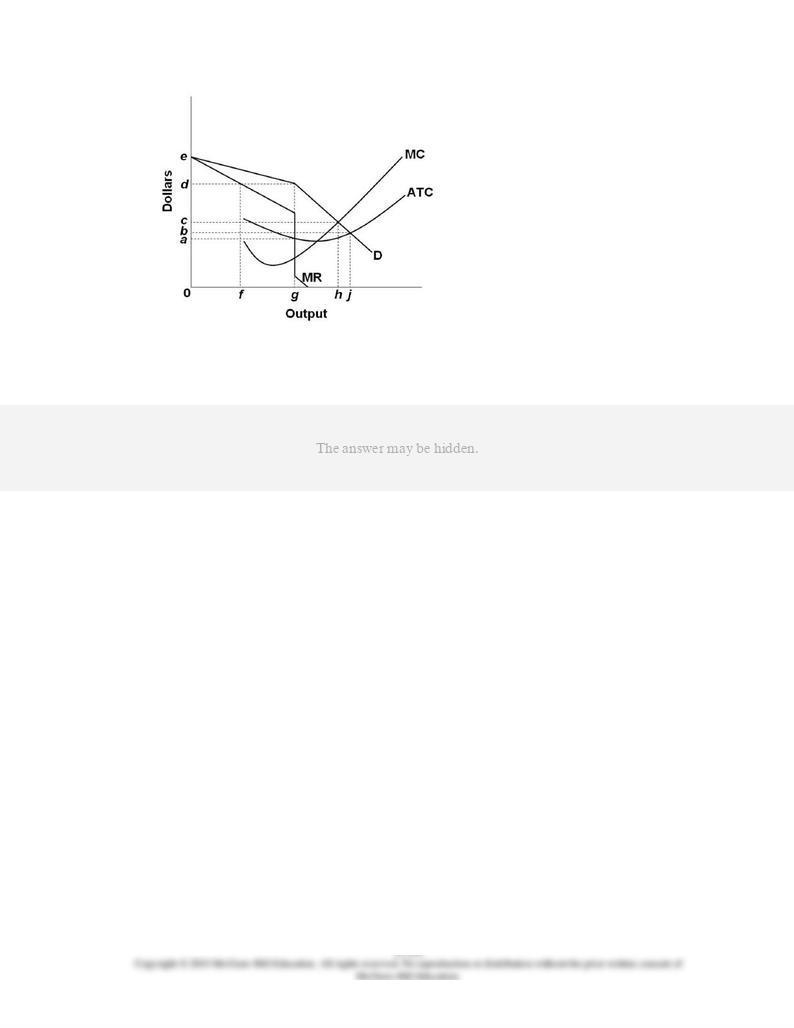
157.
Refer to the diagram. Equilibrium output is:
AACSB: Reflective Thinking
Blooms: Analyze
Difficulty: 3 Hard
Learning Objective: 13-07 Explain the three main models of oligopoly pricing and output: kinked-demand theory; collusive
pricing; and price leadership.
Topic: Three oligopoly models: kinked-demand curve model
Type: Graph
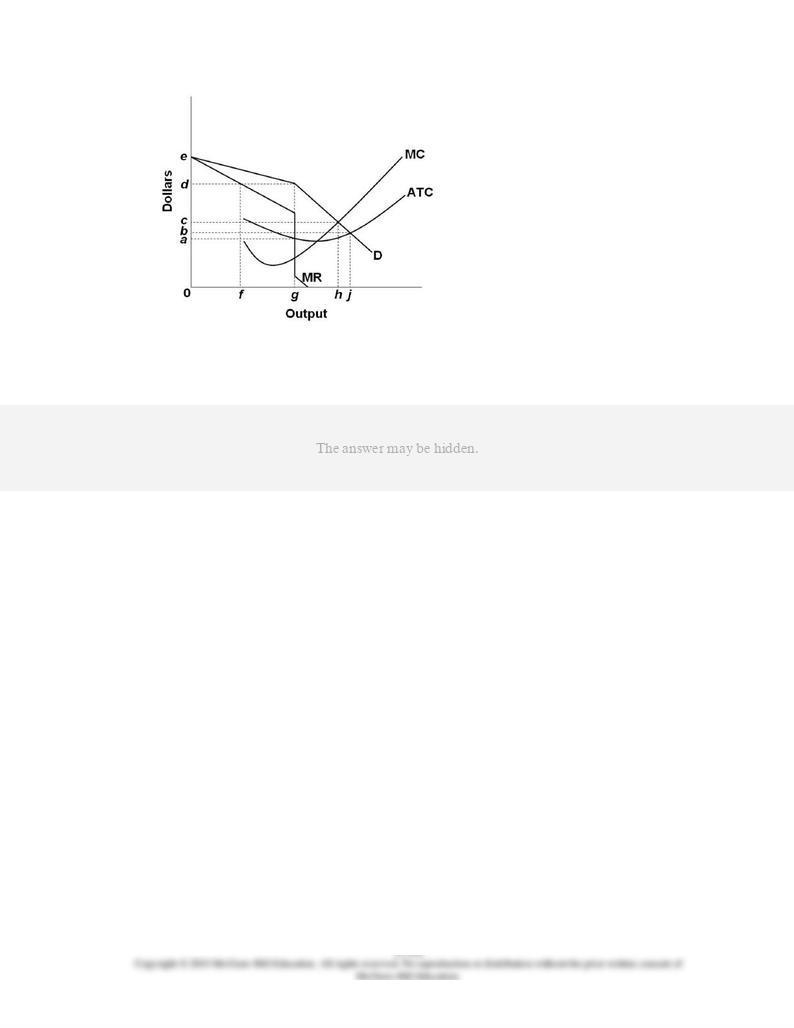
158.
Refer to the diagram. Equilibrium price is:
AACSB: Reflective Thinking
Blooms: Analyze
Difficulty: 3 Hard
Learning Objective: 13-07 Explain the three main models of oligopoly pricing and output: kinked-demand theory; collusive
pricing; and price leadership.
Topic: Three oligopoly models: kinked-demand curve model
Type: Graph

159.
Refer to the diagram. This firm's demand and marginal revenue curves are based on the
assumption that:
AACSB: Reflective Thinking
Blooms: Understand
Difficulty: 2 Medium
Learning Objective: 13-07 Explain the three main models of oligopoly pricing and output: kinked-demand theory; collusive
pricing; and price leadership.
Topic: Three oligopoly models: kinked-demand curve model
Type: Graph
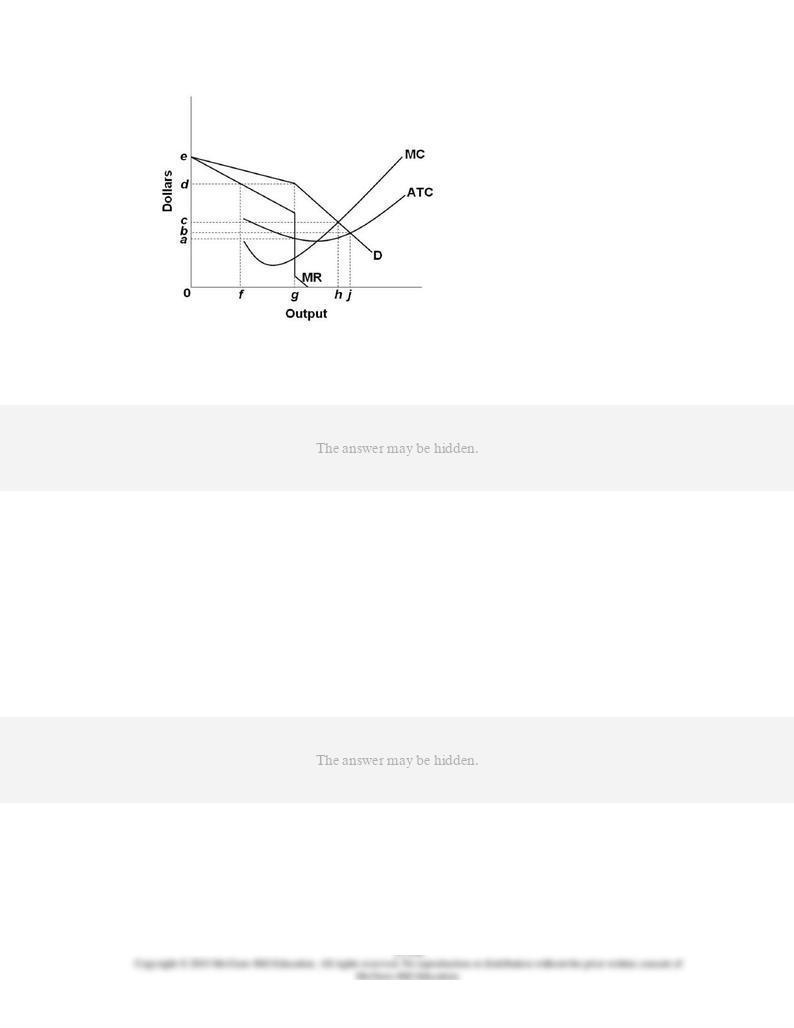
160.
Refer to the diagram. In equilibrium the firm:
AACSB: Reflective Thinking
Blooms: Analyze
Difficulty: 3 Hard
Learning Objective: 13-07 Explain the three main models of oligopoly pricing and output: kinked-demand theory; collusive
pricing; and price leadership.
Topic: Three oligopoly models: kinked-demand curve model
Type: Graph
161.
OPEC provides an example of:
AACSB: Reflective Thinking
Accessibility: Keyboard Navigation
Blooms: Remember
Difficulty: 1 Easy
Learning Objective: 13-07 Explain the three main models of oligopoly pricing and output: kinked-demand theory; collusive
pricing; and price leadership.

Topic: Three oligopoly models: cartels and other collusion
162.
Oligopolistic firms engage in collusion to:
AACSB: Reflective Thinking
Accessibility: Keyboard Navigation
Blooms: Understand
Difficulty: 2 Medium
Learning Objective: 13-07 Explain the three main models of oligopoly pricing and output: kinked-demand theory; collusive
pricing; and price leadership.
Topic: Three oligopoly models: cartels and other collusion
163.
The likelihood of a cartel being successful is greater when:
AACSB: Analytic
Accessibility: Keyboard Navigation
Blooms: Understand
Difficulty: 2 Medium
Learning Objective: 13-07 Explain the three main models of oligopoly pricing and output: kinked-demand theory; collusive
pricing; and price leadership.
Topic: Three oligopoly models: cartels and other collusion

164.
Cartels are difficult to maintain in the long run because:
AACSB: Reflective Thinking
Accessibility: Keyboard Navigation
Blooms: Understand
Difficulty: 2 Medium
Learning Objective: 13-07 Explain the three main models of oligopoly pricing and output: kinked-demand theory; collusive
pricing; and price leadership.
Topic: Three oligopoly models: cartels and other collusion
165.
Three major means of collusion by oligopolists are:
AACSB: Analytic
Accessibility: Keyboard Navigation
Blooms: Remember
Difficulty: 1 Easy
Learning Objective: 13-07 Explain the three main models of oligopoly pricing and output: kinked-demand theory; collusive
pricing; and price leadership.
Topic: Three oligopoly models: cartels and other collusion
166.
If the firms in an oligopolistic industry can establish an effective cartel, the resulting
output and price will approximate those of:
AACSB: Reflective Thinking

Accessibility: Keyboard Navigation
Blooms: Understand
Difficulty: 2 Medium
Learning Objective: 13-07 Explain the three main models of oligopoly pricing and output: kinked-demand theory; collusive
pricing; and price leadership.
Topic: Three oligopoly models: cartels and other collusion
167.
In the United States cartels are:
AACSB: Reflective Thinking
Accessibility: Keyboard Navigation
Blooms: Remember
Difficulty: 1 Easy
Learning Objective: 13-07 Explain the three main models of oligopoly pricing and output: kinked-demand theory; collusive
pricing; and price leadership.
Topic: Three oligopoly models: cartels and other collusion
168.
One would expect that collusion among oligopolistic producers would be easiest to
achieve in which of the following cases?
AACSB: Reflective Thinking
Accessibility: Keyboard Navigation
Blooms: Understand
Difficulty: 2 Medium
Learning Objective: 13-07 Explain the three main models of oligopoly pricing and output: kinked-demand theory; collusive
pricing; and price leadership.
Topic: Three oligopoly models: cartels and other collusion

169.
Suppose the only three existing manufacturers of video game players signed a written
contract by which each agreed to charge the same price for products and to distribute
their products only in the geographical area assigned them in the contract. This best
describes:
AACSB: Reflective Thinking
Accessibility: Keyboard Navigation
Blooms: Apply
Difficulty: 2 Medium
Learning Objective: 13-07 Explain the three main models of oligopoly pricing and output: kinked-demand theory; collusive
pricing; and price leadership.
Topic: Three oligopoly models: cartels and other collusion
170.
Suppose firms in a collusive oligopoly decide to establish their prices at a level that
discourages new rivals from entering the industry. This is called:
AACSB: Analytic
Accessibility: Keyboard Navigation
Blooms: Remember
Difficulty: 1 Easy
Learning Objective: 13-07 Explain the three main models of oligopoly pricing and output: kinked-demand theory; collusive
pricing; and price leadership.
Topic: Three oligopoly models: cartels and other collusion

171.
If the several oligopolistic firms that comprise an industry behave collusively, the resulting
price and output will most likely resemble those of:
AACSB: Reflective Thinking
Accessibility: Keyboard Navigation
Blooms: Understand
Difficulty: 2 Medium
Learning Objective: 13-07 Explain the three main models of oligopoly pricing and output: kinked-demand theory; collusive
pricing; and price leadership.
Topic: Three oligopoly models: cartels and other collusion
172.
Other things equal, cartels and similar collusive arrangements are easier to establish and
maintain:
AACSB: Reflective Thinking
Accessibility: Keyboard Navigation
Blooms: Understand
Difficulty: 2 Medium
Learning Objective: 13-07 Explain the three main models of oligopoly pricing and output: kinked-demand theory; collusive
pricing; and price leadership.
Topic: Three oligopoly models: cartels and other collusion

173.
A breakdown in price leadership leading to successive rounds of price cuts is known as:
AACSB: Analytic
Accessibility: Keyboard Navigation
Blooms: Remember
Difficulty: 1 Easy
Learning Objective: 13-07 Explain the three main models of oligopoly pricing and output: kinked-demand theory; collusive
pricing; and price leadership.
Topic: Three oligopoly models: price leadership
174.
Which of the following nations is not a member of the OPEC oil cartel?
A.
Saudi Arabia.
B.
Iran.
AACSB: Reflective Thinking
Accessibility: Keyboard Navigation
Blooms: Remember
Difficulty: 1 Easy
Learning Objective: 13-07 Explain the three main models of oligopoly pricing and output: kinked-demand theory; collusive
pricing; and price leadership.
Topic: Three oligopoly models: cartels and other collusion
175.
Which of the following companies was
not
fined in 2011 for attempting to run an
international cartel and fix prices?
AACSB: Reflective Thinking

Accessibility: Keyboard Navigation
Blooms: Remember
Difficulty: 1 Easy
Learning Objective: 13-07 Explain the three main models of oligopoly pricing and output: kinked-demand theory; collusive
pricing; and price leadership.
Topic: Three oligopoly models: cartels and other collusion
176.
Secret conspiracies to fix prices are examples of:
AACSB: Reflective Thinking
Accessibility: Keyboard Navigation
Blooms: Understand
Difficulty: 2 Medium
Learning Objective: 13-07 Explain the three main models of oligopoly pricing and output: kinked-demand theory; collusive
pricing; and price leadership.
Topic: Three oligopoly models: cartels and other collusion
177.
In 2011, advertising expenditures in the United States were:
AACSB: Reflective Thinking
Accessibility: Keyboard Navigation
Blooms: Remember
Difficulty: 1 Easy
Learning Objective: 13-08 Contrast the potential positive and negative effects of advertising.
Topic: Oligopoly and advertising

178.
Advertising can enhance economic efficiency when it:
AACSB: Reflective Thinking
Accessibility: Keyboard Navigation
Blooms: Understand
Difficulty: 2 Medium
Learning Objective: 13-08 Contrast the potential positive and negative effects of advertising.
Topic: Oligopoly and advertising
179.
Advertising can enhance economic efficiency when it:
AACSB: Reflective Thinking
Accessibility: Keyboard Navigation
Blooms: Understand
Difficulty: 2 Medium
Learning Objective: 13-08 Contrast the potential positive and negative effects of advertising.
Topic: Oligopoly and advertising
180.
Advertising can impede economic efficiency when it:
AACSB: Reflective Thinking
Accessibility: Keyboard Navigation
Blooms: Understand
Difficulty: 2 Medium

Learning Objective: 13-08 Contrast the potential positive and negative effects of advertising.
Topic: Oligopoly and advertising
181.
Advertising can impede economic efficiency when it:
AACSB: Reflective Thinking
Accessibility: Keyboard Navigation
Blooms: Understand
Difficulty: 2 Medium
Learning Objective: 13-08 Contrast the potential positive and negative effects of advertising.
Topic: Oligopoly and advertising
182.
We would expect a cartel to achieve:
AACSB: Reflective Thinking
Accessibility: Keyboard Navigation
Blooms: Understand
Difficulty: 2 Medium
Learning Objective: 13-09 Discuss the efficiency of oligopoly from society's standpoint and whether it is more or less
efficient than monopoly.
Topic: Oligopoly and efficiency

183.
Suppose that a particular industry has a four-firm concentration ratio of 85 and a
Herfindahl index of 3,000. Most likely, this industry would achieve:
AACSB: Reflective Thinking
Accessibility: Keyboard Navigation
Blooms: Apply
Difficulty: 2 Medium
Learning Objective: 13-09 Discuss the efficiency of oligopoly from society's standpoint and whether it is more or less
efficient than monopoly.
Topic: Oligopoly and efficiency
184.
Suppose that an industry is characterized by a few firms and price leadership. We would
expect that:
AACSB: Reflective Thinking
Accessibility: Keyboard Navigation
Blooms: Understand
Difficulty: 2 Medium
Learning Objective: 13-09 Discuss the efficiency of oligopoly from society's standpoint and whether it is more or less
efficient than monopoly.
Topic: Oligopoly and efficiency

185.
The conclusion that oligopoly is inefficient relative to the competitive ideal must be
qualified because:
AACSB: Reflective Thinking
Accessibility: Keyboard Navigation
Blooms: Understand
Difficulty: 2 Medium
Learning Objective: 13-09 Discuss the efficiency of oligopoly from society's standpoint and whether it is more or less
efficient than monopoly.
Topic: Oligopoly and efficiency
186.
(Consider This) The story about three sellers of Native American arts and crafts best
illustrates the idea of:
AACSB: Reflective Thinking
Accessibility: Keyboard Navigation
Blooms: Apply
Difficulty: 2 Medium
Learning Objective: 13-05 Describe the characteristics of oligopoly.
Topic: Oligopoly: characteristics
Topic: Oligopoly: definition

187.
(Consider This) The Native American arts and crafts story illustrates the twin ideas of:
AACSB: Reflective Thinking
Accessibility: Keyboard Navigation
Blooms: Apply
Difficulty: 2 Medium
Learning Objective: 13-05 Describe the characteristics of oligopoly.
Topic: Oligopoly: characteristics
Topic: Oligopoly: definition
188.
(Consider This) The prisoner's dilemma is generally demonstrated through:
AACSB: Reflective Thinking
Accessibility: Keyboard Navigation
Blooms: Remember
Difficulty: 1 Easy
Learning Objective: 13-06 Discuss how game theory relates to oligopoly.
Topic: Oligopoly behavior: game-theory overview
189.
(Consider This) The prisoner's dilemma reveals that:
AACSB: Reflective Thinking
Accessibility: Keyboard Navigation

Blooms: Understand
Difficulty: 2 Medium
Learning Objective: 13-06 Discuss how game theory relates to oligopoly.
Topic: Oligopoly behavior: game-theory overview
190.
(Last Word) Which of the following statements best describes the Internet market
structure?
AACSB: Reflective Thinking
Accessibility: Keyboard Navigation
Blooms: Understand
Difficulty: 2 Medium
Learning Objective: 13-05 Describe the characteristics of oligopoly.
Topic: Oligopoly: characteristics
Topic: Oligopoly: definition
191.
(Last Word) In the Internet search market:
AACSB: Reflective Thinking
Accessibility: Keyboard Navigation
Blooms: Remember
Difficulty: 1 Easy
Learning Objective: 13-05 Describe the characteristics of oligopoly.
Topic: Oligopoly: characteristics
Topic: Oligopoly: definition

192.
(Last Word) Major Internet-related firms such as Google, Apple, Amazon, Microsoft, and
Facebook each has an area of the market that it dominates. Which of the following is true
about their interaction in the market?
AACSB: Reflective Thinking
Accessibility: Keyboard Navigation
Blooms: Understand
Difficulty: 2 Medium
Learning Objective: 13-05 Describe the characteristics of oligopoly.
Topic: Oligopoly: characteristics
Topic: Oligopoly: definition
193.
(Last Word) Microsoft:
AACSB: Reflective Thinking
Accessibility: Keyboard Navigation
Blooms: Remember
Difficulty: 1 Easy
Learning Objective: 13-05 Describe the characteristics of oligopoly.
Topic: Oligopoly: characteristics
Topic: Oligopoly: definition

194.
(Last Word) Which market structure best characterizes the various Internet markets?
AACSB: Reflective Thinking
Accessibility: Keyboard Navigation
Blooms: Understand
Difficulty: 2 Medium
Learning Objective: 13-05 Describe the characteristics of oligopoly.
Topic: Oligopoly: characteristics
Topic: Oligopoly: definition
True / False Questions
195.
In the long run, monopolistically competitive firms make normal profits because they are
forced to operate at the minimum point on their average total cost curve.
AACSB: Reflective Thinking
Accessibility: Keyboard Navigation
Blooms: Understand
Difficulty: 2 Medium
Learning Objective: 13-02 Explain why monopolistic competitors earn only a normal profit in the long run.
Topic: Price and output in monopolistic competition
196.
The monopolistically competitive seller maximizes profits by equating price and marginal
cost.
AACSB: Reflective Thinking
Accessibility: Keyboard Navigation
Blooms: Understand
Difficulty: 2 Medium

Learning Objective: 13-02 Explain why monopolistic competitors earn only a normal profit in the long run.
Topic: Price and output in monopolistic competition
197.
Monopolistically competitive firms are inefficient because they produce at a point on the
rising segment of their average cost curves.
AACSB: Reflective Thinking
Accessibility: Keyboard Navigation
Blooms: Understand
Difficulty: 2 Medium
Learning Objective: 13-03 Explain why monopolistic competition delivers neither productive nor allocative efficiency.
Topic: Monopolistic competition and efficiency
198.
The demand curve of a monopolistically competitive producer is less elastic than that of a
purely competitive producer.
AACSB: Reflective Thinking
Accessibility: Keyboard Navigation
Blooms: Remember
Difficulty: 1 Easy
Learning Objective: 13-02 Explain why monopolistic competitors earn only a normal profit in the long run.
Topic: Price and output in monopolistic competition
199.
The larger the number of firms and the less the degree of product differentiation, the
greater will be the elasticity of a monopolistically competitive seller's demand curve.
AACSB: Reflective Thinking
Accessibility: Keyboard Navigation
Blooms: Understand
Difficulty: 2 Medium
Learning Objective: 13-02 Explain why monopolistic competitors earn only a normal profit in the long run.
Topic: Price and output in monopolistic competition

200.
The economic profits earned by monopolistically competitive sellers are zero in the long
run.
AACSB: Reflective Thinking
Accessibility: Keyboard Navigation
Blooms: Understand
Difficulty: 2 Medium
Learning Objective: 13-02 Explain why monopolistic competitors earn only a normal profit in the long run.
Topic: Price and output in monopolistic competition
201.
The excess capacity problem associated with monopolistic competition implies that fewer
firms could produce the same industry output at a lower total cost.
AACSB: Reflective Thinking
Accessibility: Keyboard Navigation
Blooms: Analyze
Difficulty: 3 Hard
Learning Objective: 13-02 Explain why monopolistic competitors earn only a normal profit in the long run.
Topic: Price and output in monopolistic competition
202.
The demand curve of a monopolistically competitive firm is more elastic than that of a
pure monopolist.
AACSB: Reflective Thinking
Accessibility: Keyboard Navigation
Blooms: Understand
Difficulty: 2 Medium
Learning Objective: 13-02 Explain why monopolistic competitors earn only a normal profit in the long run.
Topic: Price and output in monopolistic competition
203.
Monopolistically competitive sellers realize economic profits in the long run because entry
barriers are significant.
AACSB: Reflective Thinking
Accessibility: Keyboard Navigation

Blooms: Understand
Difficulty: 2 Medium
Learning Objective: 13-02 Explain why monopolistic competitors earn only a normal profit in the long run.
Topic: Price and output in monopolistic competition
204.
Monopolistically competitive sellers produce efficiently because they obtain only normal
profits in the long run.
AACSB: Reflective Thinking
Accessibility: Keyboard Navigation
Blooms: Understand
Difficulty: 2 Medium
Learning Objective: 13-03 Explain why monopolistic competition delivers neither productive nor allocative efficiency.
Topic: Monopolistic competition and efficiency
205.
The oligopolist's kinked-demand curve is highly elastic below and highly inelastic above
the going product price.
AACSB: Reflective Thinking
Accessibility: Keyboard Navigation
Blooms: Remember
Difficulty: 1 Easy
Learning Objective: 13-07 Explain the three main models of oligopoly pricing and output: kinked-demand theory; collusive
pricing; and price leadership.
Topic: Three oligopoly models: kinked-demand curve model
206.
Mutual interdependence means that oligopolistic producers rely primarily on price
competition in determining their shares of the total market for their product.
AACSB: Reflective Thinking
Accessibility: Keyboard Navigation
Blooms: Understand
Difficulty: 2 Medium
Learning Objective: 13-05 Describe the characteristics of oligopoly.
Topic: Oligopoly: characteristics
Topic: Oligopoly: definition

207.
If an oligopolist's several rivals exactly match any price changes it initiates, the demand
curve will be less elastic than if its price changes are ignored by its rivals.
AACSB: Reflective Thinking
Accessibility: Keyboard Navigation
Blooms: Understand
Difficulty: 2 Medium
Learning Objective: 13-07 Explain the three main models of oligopoly pricing and output: kinked-demand theory; collusive
pricing; and price leadership.
Topic: Three oligopoly models: kinked-demand curve model
208.
If three or four homogeneous oligopolists collude, the resulting price and production
outcomes will be similar to those of pure monopoly.
AACSB: Reflective Thinking
Accessibility: Keyboard Navigation
Blooms: Understand
Difficulty: 2 Medium
Learning Objective: 13-07 Explain the three main models of oligopoly pricing and output: kinked-demand theory; collusive
pricing; and price leadership.
Topic: Three oligopoly models: cartels and other collusion
209.
All other things equal, the larger the number of firms in an oligopolistic industry, the more
difficult it is for those firms to collude.
AACSB: Analytic
Accessibility: Keyboard Navigation
Blooms: Understand
Difficulty: 2 Medium
Learning Objective: 13-07 Explain the three main models of oligopoly pricing and output: kinked-demand theory; collusive
pricing; and price leadership.
Topic: Three oligopoly models: cartels and other collusion

210.
Generally speaking, oligopolistic industries producing raw materials and semifinished
goods usually offer differentiated products, while oligopolists producing consumer goods
usually offer standardized products.
AACSB: Reflective Thinking
Accessibility: Keyboard Navigation
Blooms: Understand
Difficulty: 2 Medium
Learning Objective: 13-05 Describe the characteristics of oligopoly.
Topic: Oligopoly: characteristics
Topic: Oligopoly: definition
211.
Two industries that have the same four-firm concentration ratio can have significantly
different Herfindahl indexes.
AACSB: Reflective Thinking
Accessibility: Keyboard Navigation
Blooms: Understand
Difficulty: 2 Medium
Learning Objective: 13-05 Describe the characteristics of oligopoly.
Topic: Oligopoly: characteristics
Topic: Oligopoly: definition
212.
As it relates to oligopoly, game theory focuses on the strategic behavior of rival firms.
AACSB: Reflective Thinking
Accessibility: Keyboard Navigation
Blooms: Understand
Difficulty: 2 Medium
Learning Objective: 13-06 Discuss how game theory relates to oligopoly.
Topic: Oligopoly behavior: game-theory overview
213.
The highest possible value of the Herfindahl index is 1,000.
AACSB: Reflective Thinking

Accessibility: Keyboard Navigation
Blooms: Remember
Difficulty: 1 Easy
Learning Objective: 13-05 Describe the characteristics of oligopoly.
Topic: Oligopoly: characteristics
Topic: Oligopoly: definition
214.
The U.S. breakfast cereal industry is an example of differentiated oligopoly.
AACSB: Reflective Thinking
Accessibility: Keyboard Navigation
Blooms: Apply
Difficulty: 2 Medium
Learning Objective: 13-05 Describe the characteristics of oligopoly.
Topic: Oligopoly: characteristics
Topic: Oligopoly: definition
215.
The U.S. steel industry is an example of homogeneous oligopoly.
AACSB: Reflective Thinking
Accessibility: Keyboard Navigation
Blooms: Apply
Difficulty: 2 Medium
Learning Objective: 13-05 Describe the characteristics of oligopoly.
Topic: Oligopoly: characteristics
Topic: Oligopoly: definition
216.
Homogeneous oligopolists tend to advertise more than do differentiated oligopolists.
AACSB: Reflective Thinking
Accessibility: Keyboard Navigation
Blooms: Understand
Difficulty: 2 Medium
Learning Objective: 13-08 Contrast the potential positive and negative effects of advertising.
Topic: Oligopoly and advertising

217.
Oligopolists use limit pricing to maximize short-run profits.
AACSB: Reflective Thinking
Accessibility: Keyboard Navigation
Blooms: Understand
Difficulty: 2 Medium
Learning Objective: 13-07 Explain the three main models of oligopoly pricing and output: kinked-demand theory; collusive
pricing; and price leadership.
Topic: Three oligopoly models: cartels and other collusion
218.
Both collusive and noncollusive oligopoly models suggest that price changes will be
relatively infrequent in these types of industries.
AACSB: Reflective Thinking
Accessibility: Keyboard Navigation
Blooms: Understand
Difficulty: 2 Medium
Learning Objective: 13-07 Explain the three main models of oligopoly pricing and output: kinked-demand theory; collusive
pricing; and price leadership.
Topic: Three oligopoly models
219.
Collusion among firms always involves formal agreements.
AACSB: Reflective Thinking
Accessibility: Keyboard Navigation
Blooms: Understand
Difficulty: 2 Medium
Learning Objective: 13-07 Explain the three main models of oligopoly pricing and output: kinked-demand theory; collusive
pricing; and price leadership.
Topic: Three oligopoly models: cartels and other collusion
220.
Firms are more likely to collude when the economy is in a recession.
AACSB: Reflective Thinking
Accessibility: Keyboard Navigation
Blooms: Understand

Difficulty: 2 Medium
Learning Objective: 13-07 Explain the three main models of oligopoly pricing and output: kinked-demand theory; collusive
pricing; and price leadership.
Topic: Three oligopoly models: cartels and other collusion
Multiple Choice Questions
221.
A simultaneous game is said to exist when:
AACSB: Analytic
Accessibility: Keyboard Navigation
Blooms: Remember
Difficulty: 1 Easy
Learning Objective: 13-10 (Appendix) Utilize additional game-theory terminology and applications.
Topic: One-time game: strategies and equilibrium
222.
A positive-sum game occurs:
AACSB: Analytic
Accessibility: Keyboard Navigation
Blooms: Remember
Difficulty: 1 Easy
Learning Objective: 13-10 (Appendix) Utilize additional game-theory terminology and applications.
Topic: One-time game: strategies and equilibrium

223.
The payoff matrix represents:
AACSB: Reflective Thinking
Blooms: Apply
Difficulty: 2 Medium
Learning Objective: 13-10 (Appendix) Utilize additional game-theory terminology and applications.
Topic: One-time game: strategies and equilibrium
Type: Figure
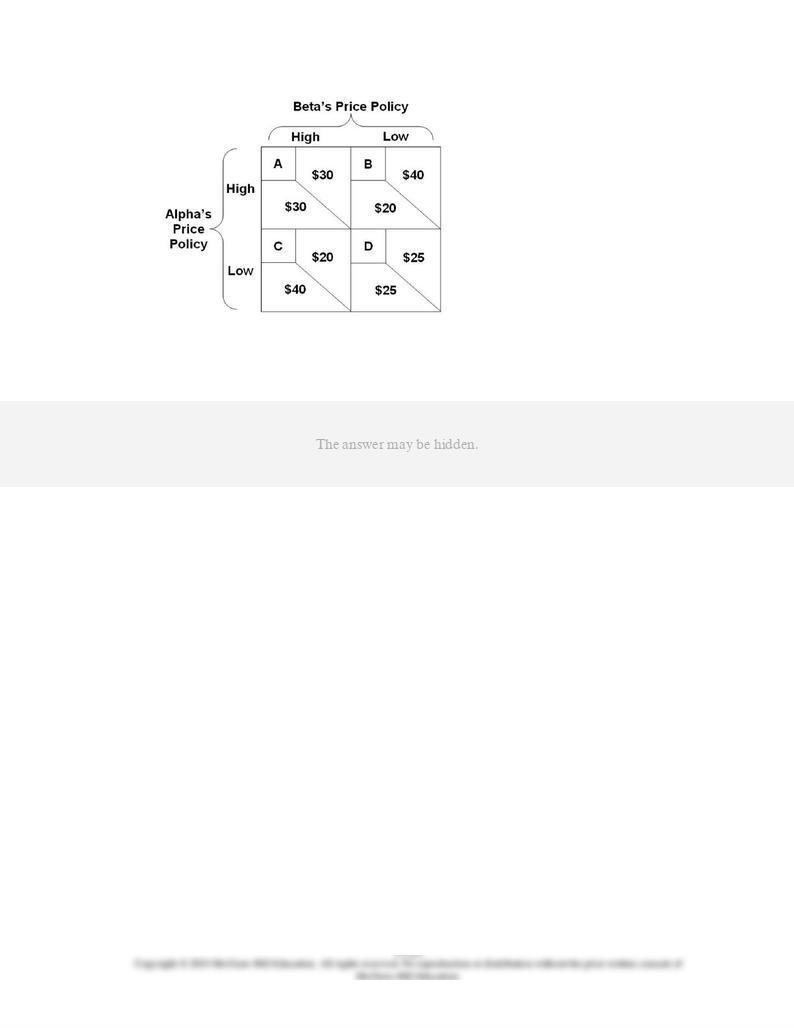
224.
In the payoff matrix:
AACSB: Analytic
Blooms: Apply
Difficulty: 2 Medium
Learning Objective: 13-10 (Appendix) Utilize additional game-theory terminology and applications.
Topic: One-time game: strategies and equilibrium
Type: Figure

225.
In the payoff matrix shown:
AACSB: Analytic
Blooms: Apply
Difficulty: 2 Medium
Learning Objective: 13-10 (Appendix) Utilize additional game-theory terminology and applications.
Topic: One-time game: strategies and equilibrium
Type: Figure

226.
Refer to the payoff matrix. Which cell represents the outcome of this game?
AACSB: Analytic
Blooms: Analyze
Difficulty: 3 Hard
Learning Objective: 13-10 (Appendix) Utilize additional game-theory terminology and applications.
Topic: One-time game: strategies and equilibrium
Type: Figure

227.
Refer to the payoff matrix. Which of the following statements is true regarding the
outcome of this game?
AACSB: Analytic
Blooms: Analyze
Difficulty: 3 Hard
Learning Objective: 13-10 (Appendix) Utilize additional game-theory terminology and applications.
Topic: One-time game: strategies and equilibrium
Type: Figure
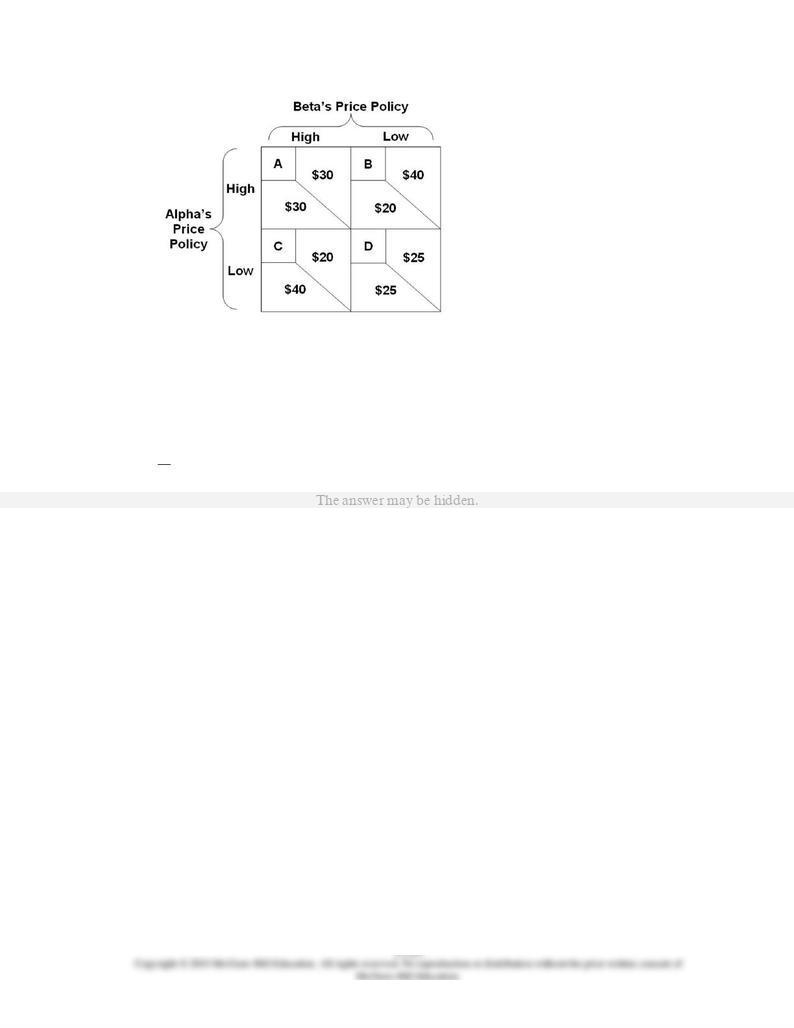
228.
Refer to the payoff matrix. Which of the following statements is true regarding the
outcome of this game?
A.
Both firms will price high, and this outcome is a prisoner's dilemma.
B.
Both firms will price low, and this outcome is a prisoner's dilemma.
C.
Both firms will price high, but this outcome is
not
a prisoner's dilemma.
AACSB: Analytic
Blooms: Analyze
Difficulty: 3 Hard
Learning Objective: 13-10 (Appendix) Utilize additional game-theory terminology and applications.
Topic: One-time game: strategies and equilibrium
Type: Figure
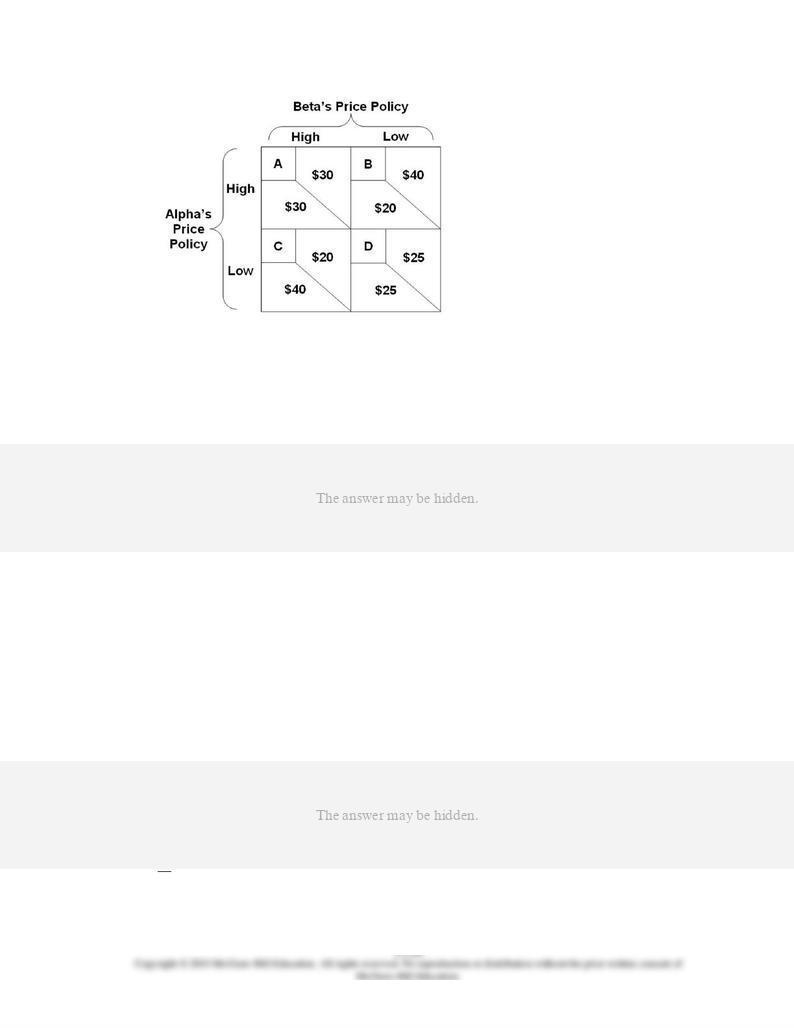
229.
Refer to the payoff matrix. Suppose that Alpha and Beta agree that they will both pursue a
high-price strategy. If Beta then cheats on the agreement in order to increase profits,
which of the following is true?
AACSB: Analytic
Blooms: Analyze
Difficulty: 3 Hard
Learning Objective: 13-10 (Appendix) Utilize additional game-theory terminology and applications.
Topic: Repeated games and reciprocity strategies
Type: Figure
230.
Collusive agreements between two firms are most likely to be honored when the game:
AACSB: Reflective Thinking
Accessibility: Keyboard Navigation

Blooms: Understand
Difficulty: 2 Medium
Learning Objective: 13-10 (Appendix) Utilize additional game-theory terminology and applications.
Topic: Credible and empty threats
Topic: Repeated games and reciprocity strategies
231.
Zippy's and Tony's are rival pizza restaurants in a small town (together they form a local
duopoly). Zippy's management determines that if it increases its advertising expenditures,
it will increase profits regardless of whether Tony's increases its advertising budget.
Based on this information, we can conclude that:
AACSB: Reflective Thinking
Accessibility: Keyboard Navigation
Blooms: Apply
Difficulty: 2 Medium
Learning Objective: 13-10 (Appendix) Utilize additional game-theory terminology and applications.
Topic: One-time game: strategies and equilibrium
232.
Larry's Lizards and Ronaldo's Reptiles are competing pet store franchises. Both are
considering opening a store in the small town of Turtleville. If Ronaldo's opens a profitable
store in Turtleville and Larry's management determines that it is not profitable to also
open a store, then:
AACSB: Reflective Thinking
Accessibility: Keyboard Navigation
Blooms: Apply
Difficulty: 2 Medium
Learning Objective: 13-10 (Appendix) Utilize additional game-theory terminology and applications.
Topic: First-mover advantages and preemption of entry
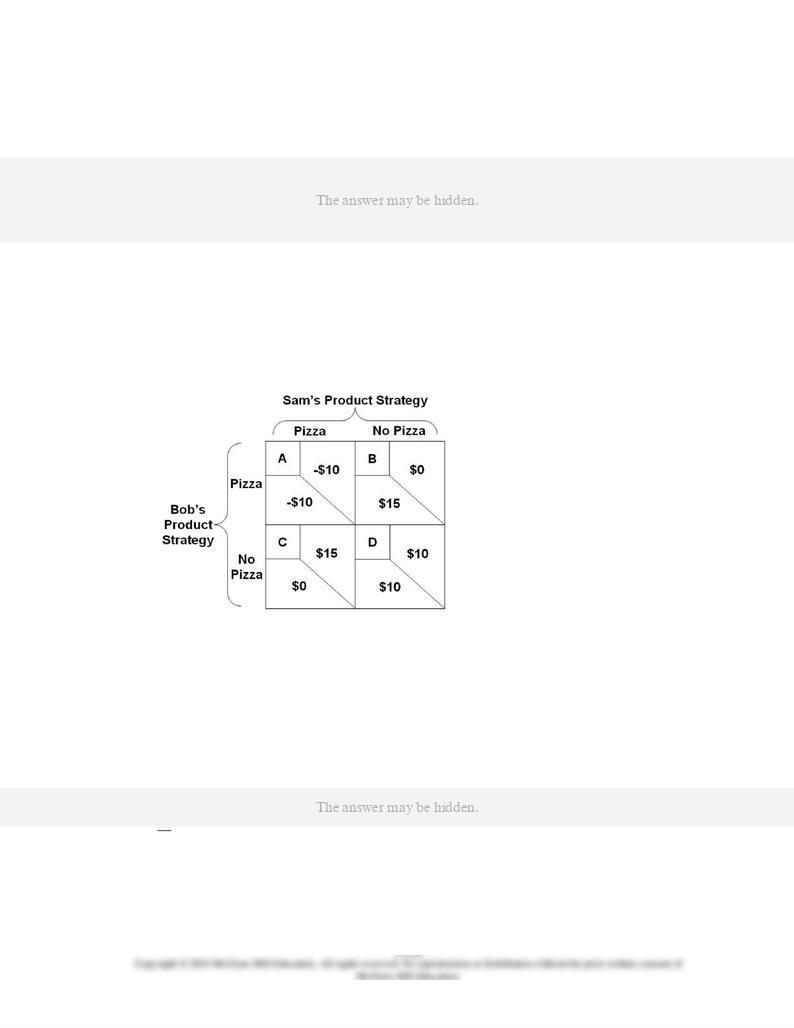
233.
In a sequential game, the first mover into a new market:
AACSB: Reflective Thinking
Accessibility: Keyboard Navigation
Blooms: Understand
Difficulty: 2 Medium
Learning Objective: 13-10 (Appendix) Utilize additional game-theory terminology and applications.
Topic: First-mover advantages and preemption of entry
234.
Refer to the payoff matrix. Bob's Burgers and Sam's Sandwiches are competing
restaurants in a small town. Both are considering adding pizza to their line of products. If
this is a one-time simultaneous game:
A.
both firms have a dominant strategy to add pizza to their menu.
B.
both firms have a dominant strategy to
not
add pizza to their menu.
AACSB: Analytic
Blooms: Apply
Difficulty: 2 Medium
Learning Objective: 13-10 (Appendix) Utilize additional game-theory terminology and applications.

Topic: One-time game: strategies and equilibrium
Type: Figure
235.
Refer to the payoff matrix. Bob's Burgers and Sam's Sandwiches are competing
restaurants in a small town. Both are considering adding pizza to their line of products. If
this is a sequential game:
AACSB: Analytic
Blooms: Analyze
Difficulty: 3 Hard
Learning Objective: 13-10 (Appendix) Utilize additional game-theory terminology and applications.
Topic: First-mover advantages and preemption of entry
Type: Figure

236.
Refer to the payoff matrix. Bob's Burgers and Sam's Sandwiches are competing
restaurants in a small town. Both are considering adding pizza to their line of products. If
this is a sequential game and Bob's moves first, which cell represents the final outcome?
AACSB: Analytic
Blooms: Analyze
Difficulty: 3 Hard
Learning Objective: 13-10 (Appendix) Utilize additional game-theory terminology and applications.
Topic: First-mover advantages and preemption of entry
Type: Figure

237.
Refer to the payoff matrix. Bob's Burgers and Sam's Sandwiches are competing
restaurants in a small town. Both are considering adding pizza to their line of products. If
this is a sequential game but we don't know who moves first, what can we say about the
final outcome?
AACSB: Analytic
Blooms: Analyze
Difficulty: 3 Hard
Learning Objective: 13-10 (Appendix) Utilize additional game-theory terminology and applications.
Topic: First-mover advantages and preemption of entry
Type: Figure
238.
In a sequential game with two firms, the first mover into a new market:
AACSB: Reflective Thinking
Accessibility: Keyboard Navigation
Blooms: Understand

Difficulty: 2 Medium
Learning Objective: 13-10 (Appendix) Utilize additional game-theory terminology and applications.
Topic: First-mover advantages and preemption of entry
239.
Refer to the payoff matrix. Suppose that Speedy Bike and Power Bike are the only two
bicycle manufacturing firms serving the market. Both can choose large or small advertising
budgets. If this is a one-time, simultaneous game, which cell represents the final outcome
we would expect to occur?
AACSB: Analytic
Blooms: Analyze
Difficulty: 3 Hard
Learning Objective: 13-10 (Appendix) Utilize additional game-theory terminology and applications.
Topic: One-time game: strategies and equilibrium
Type: Figure
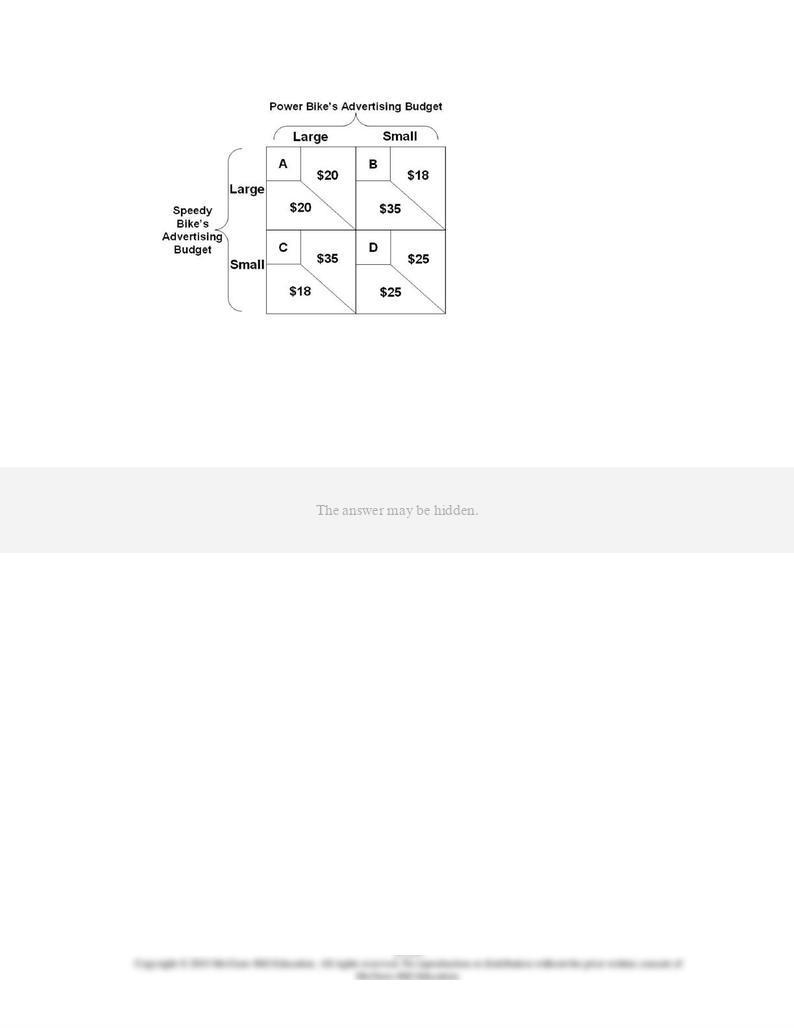
240.
Refer to the payoff matrix. Suppose that Speedy Bike and Power Bike are the only two
bicycle manufacturing firms serving the market. Both can choose large or small advertising
budgets. If this is a repeated game with no cooperation or reciprocity, which cell
represents the final outcome we would expect to occur?
AACSB: Analytic
Blooms: Analyze
Difficulty: 3 Hard
Learning Objective: 13-10 (Appendix) Utilize additional game-theory terminology and applications.
Topic: Repeated games and reciprocity strategies
Type: Figure
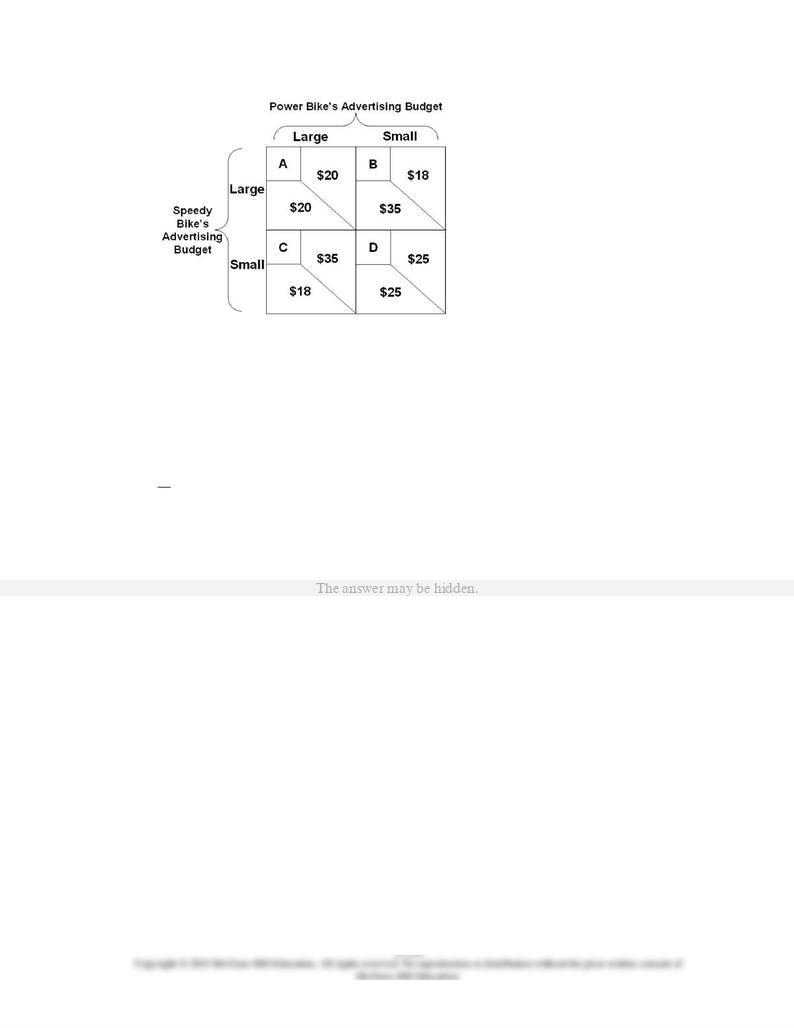
241.
Refer to the payoff matrix. Suppose that Speedy Bike and Power Bike are the only two
bicycle manufacturing firms serving the market. Both can choose large or small advertising
budgets. If this is a repeated game with no cooperation or reciprocity, cell A:
A.
is not the expected outcome of this game.
B.
is the expected outcome of this game, and it is both a Nash equilibrium and a
prisoner's dilemma.
C.
is the expected outcome of this game, but it is neither a Nash equilibrium nor a
prisoner's dilemma.
D.
is the expected outcome of this game, and it is a Nash equilibrium but not a prisoner's
AACSB: Analytic
Blooms: Analyze
Difficulty: 3 Hard
Learning Objective: 13-10 (Appendix) Utilize additional game-theory terminology and applications.
Topic: Repeated games and reciprocity strategies
Type: Figure

242.
Refer to the payoff matrix. Suppose that Speedy Bike and Power Bike are the only two
bicycle manufacturing firms serving the market. Both can choose large or small advertising
budgets. Is there a Nash equilibrium solution to this game?
AACSB: Analytic
Blooms: Analyze
Difficulty: 3 Hard
Learning Objective: 13-10 (Appendix) Utilize additional game-theory terminology and applications.
Topic: One-time game: strategies and equilibrium
Type: Figure
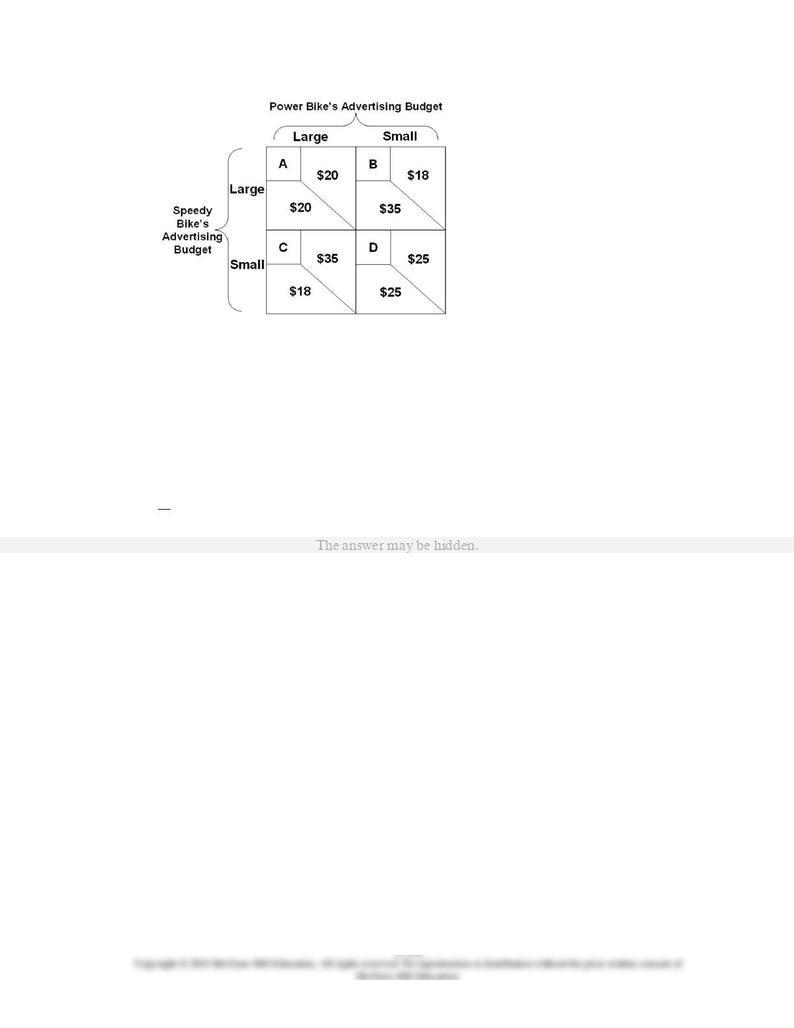
243.
Refer to the payoff matrix. Suppose that Speedy Bike and Power Bike are the only two
bicycle manufacturing firms serving the market. Both can choose large or small advertising
budgets. If this is a repeated game and the firms cooperate to maximize profits, which of
the following outcomes would we expect to occur?
A.
In repeated playing, the outcomes would alternate between cells A and D.
B.
In repeated playing, the outcomes would alternate between cells B and C.
C.
The two firms will agree to keep their advertising budgets small over time.
AACSB: Analytic
Blooms: Analyze
Difficulty: 3 Hard
Learning Objective: 13-10 (Appendix) Utilize additional game-theory terminology and applications.
Topic: Repeated games and reciprocity strategies
Type: Figure

244.
Refer to the payoff matrix. Suppose that Speedy Bike and Power Bike are the only two
bicycle manufacturing firms serving the market. Both can choose large or small advertising
budgets. If this is a repeated game, it is in the long-term best interests of both players to:
AACSB: Analytic
Blooms: Analyze
Difficulty: 3 Hard
Learning Objective: 13-10 (Appendix) Utilize additional game-theory terminology and applications.
Topic: Repeated games and reciprocity strategies
Type: Figure
245.
Which of the following best describes a Nash equilibrium?
AACSB: Analytic
Accessibility: Keyboard Navigation
Blooms: Remember

Difficulty: 1 Easy
Learning Objective: 13-10 (Appendix) Utilize additional game-theory terminology and applications.
Topic: One-time game: strategies and equilibrium
246.
In game theory, the credibility of a threat:
AACSB: Reflective Thinking
Accessibility: Keyboard Navigation
Blooms: Understand
Difficulty: 2 Medium
Learning Objective: 13-10 (Appendix) Utilize additional game-theory terminology and applications.
Topic: Credible and empty threats
True / False Questions
247.
If one player in a game has a dominant strategy, the other player must also have a
dominant strategy.
AACSB: Analytic
Accessibility: Keyboard Navigation
Blooms: Understand
Difficulty: 2 Medium
Learning Objective: 13-10 (Appendix) Utilize additional game-theory terminology and applications.
Topic: One-time game: strategies and equilibrium
248.
A player is said to have a dominant strategy when one of the options available is superior,
regardless of what strategy the other player chooses.
AACSB: Analytic

Accessibility: Keyboard Navigation
Blooms: Remember
Difficulty: 1 Easy
Learning Objective: 13-10 (Appendix) Utilize additional game-theory terminology and applications.
Topic: One-time game: strategies and equilibrium
249.
If neither player has an incentive to deviate from the outcome of a game, the outcome is a
Nash equilibrium.
AACSB: Analytic
Accessibility: Keyboard Navigation
Blooms: Remember
Difficulty: 1 Easy
Learning Objective: 13-10 (Appendix) Utilize additional game-theory terminology and applications.
Topic: One-time game: strategies and equilibrium
250.
A Nash equilibrium can only occur in repeated games.
AACSB: Reflective Thinking
Accessibility: Keyboard Navigation
Blooms: Understand
Difficulty: 2 Medium
Learning Objective: 13-10 (Appendix) Utilize additional game-theory terminology and applications.
Topic: One-time game: strategies and equilibrium
251.
One characteristic of sequential games is that they all have first-mover advantages.
AACSB: Reflective Thinking
Accessibility: Keyboard Navigation
Blooms: Understand
Difficulty: 2 Medium
Learning Objective: 13-10 (Appendix) Utilize additional game-theory terminology and applications.
Topic: First-mover advantages and preemption of entry

252.
Repeated games may involve either simultaneous or sequential decision making.
AACSB: Reflective Thinking
Accessibility: Keyboard Navigation
Blooms: Understand
Difficulty: 2 Medium
Learning Objective: 13-10 (Appendix) Utilize additional game-theory terminology and applications.
Topic: Repeated games and reciprocity strategies
253.
Negative-sum games do not exist because neither player has an incentive to play the
game.
AACSB: Reflective Thinking
Accessibility: Keyboard Navigation
Blooms: Understand
Difficulty: 2 Medium
Learning Objective: 13-10 (Appendix) Utilize additional game-theory terminology and applications.
Topic: One-time game: strategies and equilibrium
254.
In a zero-sum game, the gains by one player will be exactly offset by the losses of the
other.
AACSB: Analytic
Accessibility: Keyboard Navigation
Blooms: Remember
Difficulty: 1 Easy
Learning Objective: 13-10 (Appendix) Utilize additional game-theory terminology and applications.
Topic: One-time game: strategies and equilibrium
255.
In repeated games, players may be willing to accept lower payoffs in the short run in
exchange for greater net payoffs over the long run.
AACSB: Reflective Thinking
Accessibility: Keyboard Navigation
Blooms: Understand

Difficulty: 2 Medium
Learning Objective: 13-10 (Appendix) Utilize additional game-theory terminology and applications.
Topic: Repeated games and reciprocity strategies
256.
In repeated games, credible threats are necessary for the players to reach a Nash
equilibrium.
AACSB: Reflective Thinking
Accessibility: Keyboard Navigation
Blooms: Understand
Difficulty: 2 Medium
Learning Objective: 13-10 (Appendix) Utilize additional game-theory terminology and applications.
Topic: Credible and empty threats
Topic: Repeated games and reciprocity strategies
257.
The first mover in a sequential game always has the advantage over the second mover.
AACSB: Reflective Thinking
Accessibility: Keyboard Navigation
Blooms: Understand
Difficulty: 2 Medium
Learning Objective: 13-10 (Appendix) Utilize additional game-theory terminology and applications.
Topic: First-mover advantages and preemption of entry